- Mission Statement
- Advisors to the Board
- Military Fellows
- Jobs at MDAA
- Arizona AETOS ’25
- University of Hawaii Space Science Initiative
- USC SHIELD ’24
- USC SHIELD ’23
- USC SHIELD ’22
- USC SHIELD Alerts
- USC SHIELD in the News
- 2024 European Missile Defender of the Year and Regional IAMD Coalitions Conference
- Ronald Reagan Missile Defense Site, Vandenberg SFB
- Kauai Veteran’s Eternal Memorial and Missile Defense Viewing Site
- Lessons Learned Series
- Write Your Representative
- April 12th, 2022 U.S. Missile Defense – An Overview of Past, Current, and Future Roles and Responsibilities
- Virtual CRT: U.S. Missile Defense – An Overview of Past, Current, and Future Roles and Responsibilities
- MDAA Alert: The Roles and Responsibilities of Missile Defense
- Threat News
- Missile Defense News
- Air Defense News
- MDAA in the News
- Threat Basics
- Ukrainian War Updates
- Taiwan Incursion Updates
- Global Missile Tracker
- Space Threats Updates
- Notable Missile Tests
- Combat Launches
- Future Missile Threats
- U.S. Missile Defense
- Missile Defense of U.S. Partners
- Missile Defense Intercept Test Record
- Operational Intercepts by System
- Future BMD Systems
- Discontinued Programs
- U.S. Air Defense
- Air Defense of U.S. Partners
- Future Air Defense Systems
- Alerts Archive
- MDAA U.S. Ballistic Missile Defense Overview
- MDAA System/Issue Briefs
- MDAA Country Briefs
- Foreign Military Sales by Country
- 3D Panoramas
- Additional Resources
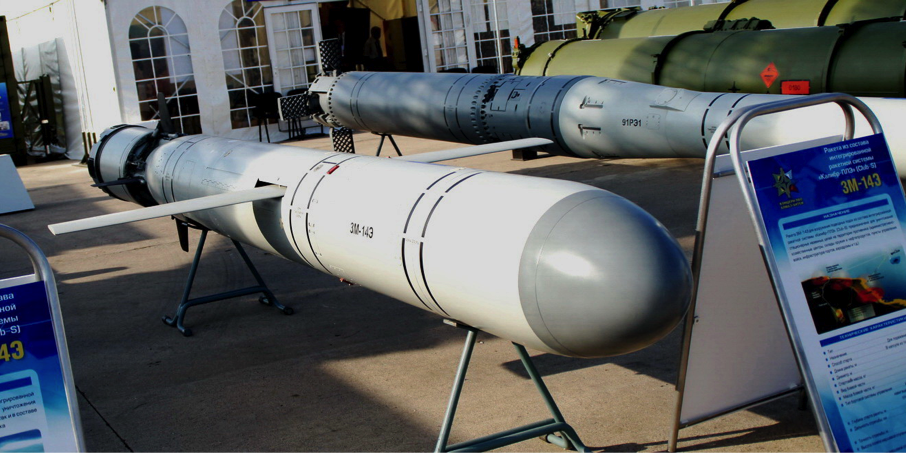
- Cruise Missile Basics

What is a cruise missile?
Cruise missiles, although similar to ballistic missiles in some regards, provide an alternate means to deliver a lethal payload rapidly and accurately to a target. Cruise missiles differ from ballistic missiles in that they fly towards their target at lower altitudes, remaining within the Earth’s atmosphere throughout their trajectory. Cruise missiles are defined as “an unmanned self-propelled guided vehicle that sustains flight through aerodynamic lift for most of its flight path and whose primary mission is to place an ordnance or special payload on a target.” [1] Unmanned aerial vehicles (UAVs) and unmanned control-guided helicopters or aircraft can be included in this definition [2] , but will not be discussed on this page.
The cruise missile has its beginnings in World War I, when the U.S. Army developed the Kettering Bug, an unmanned aerial bomb designed to strike targets beyond the range of artillery and too dangerous for piloted aircraft. However, the Kettering Bug was never used in combat. [3] Instead, the modern cruise missile originates more from the V-1 Flying Bomb used by the Germany in the last months of World War II. [4]
Launch Platforms
Cruise missiles are capable of being launched from multiple ground, air, sea and submarine platforms. Both fighter and long-range bomber aircraft are capable of carrying and launching cruise missiles. [5] On the ground, cruise missiles are most commonly launched by road-mobile systems due to the inherent advantages of mobility, but they can also be launched from fixed platforms. [6]
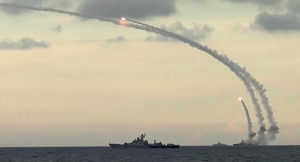
Russian warships in the Caspian Sea launch Kalibr cruise missiles towards targets inside Syria.
At sea, various surface ships and submarines can launch cruise missiles. Submarines are capable of launching while surfaced or submerged using torpedo fixtures or vertical launch tubes. [7] In April 2010 Kontsern-Morinformsistema-Agat, a Russian company, began marketing a version of the Russian Kalibr cruise missile housed in and capable of being launched from a standard shipping container. [8] This would allow any vehicle capable of carrying a standard shipping container to become a discreet platform from which to launch cruise missiles. [9]
Propulsion and Flight
Cruise missiles utilize jet engines as their primary method of propulsion. Most cruise missiles are subsonic and use Turbofan and Turbojet engines. While less common, supersonic and hypersonic cruise missiles utilize Ramjet and Scramjet engines. [10] Some also use rocket motor propulsion as a booster in the first phase of flight [11] or to accelerate to supersonic speeds in the terminal phase. [12]
Cruise missiles can fly to their targets at varying altitudes as long as they remain within the atmosphere. The trajectory of most remains close to the Earth’s surface, sometimes skimming just meters above the ground. Their low flight path makes it much harder for most radar and sensor systems to detect the missile, unless the radar or sensor system is airborne and directed towards the ground. [13] Some cruise missiles will fly only at high altitudes and dive sharply down once they reach their target. Flying at high altitude can extend the range of the missile because it’s more fuel-efficient than flying at lower altitudes. However, this also makes the missile more susceptible to missile defense systems since today’s radars and sensors are typically positioned to detect and track high altitude threats. [14] Cruise missiles can also mix their flight trajectory between high and low altitude in order to get the benefits of both. In this instance, cruise missiles will typically fly at a high altitude early in their flight to help extend their range, but as they approach their target, or missile defenses, they will fly down to a lower sea skimming/terrain hugging altitude to help it evade detection and defenses. [15]
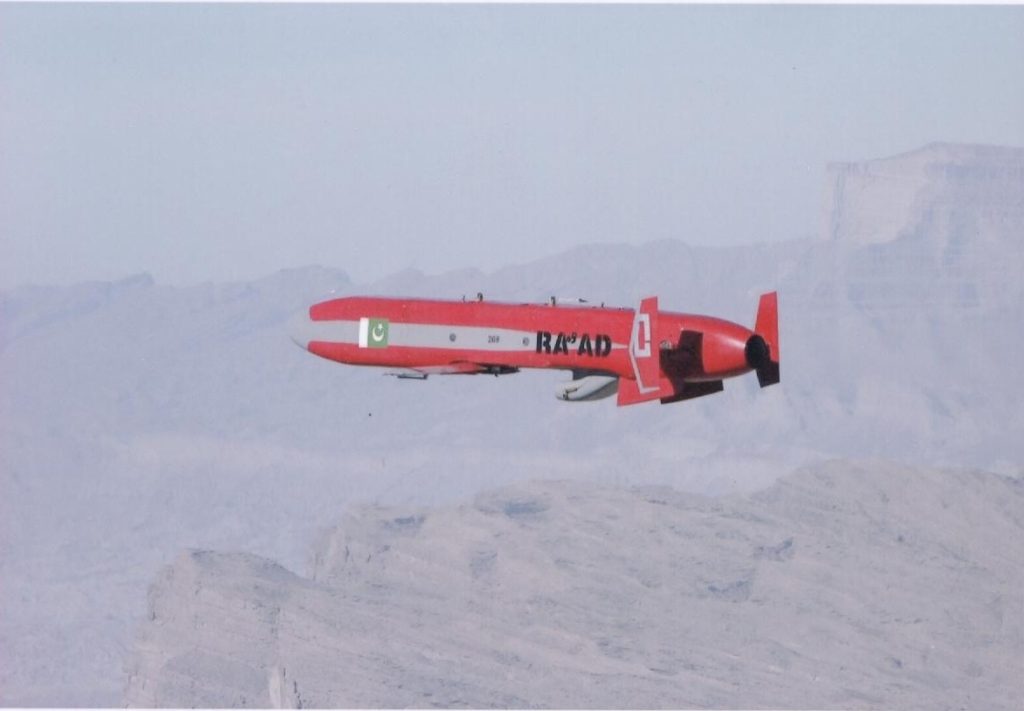
Flight test of Pakistan’s Ra’ad cruise missile.
Cruise missiles can use multiple guidance methods in order to accurately place their ordinance on the desired target and avoid missile defense systems. One of the first methods used by cruise missiles was inertial guidance, which is still used today and allows the missile to fly along a flight path programmed prior to launch. [16] Another guidance method is terrain contour matching (TERCOM), which compares a terrain map to the current terrain the missile is flying over to ensure the missile is flying on the correct path. [17] Some use GPS systems, which require connection to either GPS or GLONASS satellite system, but can help ensure the missile follows the correct flight path and strikes the final target using specific coordinates with a high degree of accuracy. [18]
Other guidance methods are primarily used in the terminal phase of flight to increase accuracy. One is a laser guided system which uses a sensor to detect its target painted by a laser, however this can be unreliable because dust and smoke can interfere with the laser or the missile may not always be able to see the laser or painted target. [19] Another terminal guidance method is TV guidance, in which an operator uses a camera in the nose of the missile to visually identify and manually guide the missile to the target in its final phase. This method also gives the operator the option to abort the strike in the final phase if an anomaly is detected. [20] A radar seeker is also used in the nose of some missiles to identify and/or keep the missile on target in the terminal phase. These radar seekers use either passive radar, which detect radar emissions of their target, or active radar, which emit their own radar to detect their target. [21] Infrared (IR) guidance – directing the missile towards heat emitting objects, such as engines [22] – may also be used by cruise missiles in the terminal phase. [23] However, because of its simplicity, IR guidance cannot differentiate between friendly, adversarial, or extraneous IR signals in a crowded battlefield, and is usually used in conjunction with other guidance systems. [24] The last guidance system used by cruise missiles is Digital Scene Matching Area Correlation (DSMAC), which uses a camera in the missile to find the desired target and match it to a stored image using an image correlator. [25]
Cruise missiles are typically armed with conventional or nuclear warheads, but can also be equipped with chemical or biological warheads. [26] The warhead weight and yield can vary widely, depending on the specific cruise missile and its mission.
[1] “Cruise Missiles.” Federation of American Scientists. http://fas.org/nuke/intro/cm/
[3] “Kettering Bug.” UAVGLOBAL. http://www.uavglobal.com/kettering-bug/ ; “War Machines: Cruise Missile.” National Geographic. https://www.youtube.com/watch?v=AD8Kr0f1tEY
[4] Hickman, Kennedy. “World War II: V-1 Flying Bomb.” About Education. http://militaryhistory.about.com/od/artillerysiegeweapons/p/v1.htm
[5] N.R.P. “Explained: How Cruise Missiles Work!” Defencyclopedia. https://defencyclopedia.com/2014/08/01/explained-how-cruise-missiles-work/
[8] Stott, Michael. “Deadly New Russian Weapon Hides in Shipping Container.” Reuters. http://www.reuters.com/article/us-russia-weapon-idUSTRE63P2XB20100426
[9] Lewis, Jeffrey, Nikolai Sokov. “Sokov on Russian Cruise Missiles.” Arms Control Wonk. http://www.armscontrolwonk.com/archive/207801/sokov-on-russian-cruise-missiles/
[11] Brain, Marshall. “How Cruise Missiles Work.” How Stuff Works. http://science.howstuffworks.com/cruise-missile.htm
[12] N.R.P. “Explained: How Cruise Missiles Work!” Defencyclopedia. https://defencyclopedia.com/2014/08/01/explained-how-cruise-missiles-work/
[22] Kopp, Carlo. “Heat-Seeking Missile Guidance.” Air Power Australia. http://ausairpower.net/TE-IR-Guidance.html
[23] N.R.P. “Explained: How Cruise Missiles Work!” Defencyclopedia. https://defencyclopedia.com/2014/08/01/explained-how-cruise-missiles-work/
[25] Brain, Marshall. “How Cruise Missiles Work.” How Stuff Works. http://science.howstuffworks.com/cruise-missile.htm
[26] “Ballistic and Cruise Missile Threat.” Federation of American Scientists. http://fas.org/irp/threat/missile/naic/part02.htm ; Norris, Robert S., Hans M. Kristensen. “Nuclear Cruise Missiles.” Bulletin of the Atomic Scientists. http://bos.sagepub.com/content/63/6/60.full
Missile Threat and Proliferation
- Missile Payload Destruction Cost Comparisons
- Technological Threat Assessment
- War By 2025 Threat Analysis
- Ballistic Missile Basics
- Hypersonic Weapon Basics
- Rocket and Mortar Basics
- Unmanned Aircraft System (UAS) Basics
- Non-State Actors
- Israel-Hamas War Updates
- United States Incursion Tracker
- World Drone Comparison
- Dong Feng-16 (CSS-11)
- Dong Feng-15 (CSS-6)
- Dong Feng-11 (CSS-7)
- M-7 (8610)/CSS-8
- Dong Feng-12 (CSS-X-15)
- Dong Feng-3 (CSS-2)
- Dong Feng-21 (CSS-5)
- Dong Feng-21D (CSS-5)
- Dong Feng-26
- Dong Feng-4 (CSS-3)
- Dong Feng-5 (DF-5)
- Dong Feng-31 (CSS-10)
- Dong Feng-41(CSS-X-20)
- DH-10 / CJ-10
- Changjian-20 (CJ-20)
- DF-ZF Hypersonic Glide Vehicle
- Dong Feng-17
- Chinese Spy Balloons
- Hwasong-17/KN-27
- Pukguksong-3 (KN-26)
- KN-02 (Toksa)
- Hwasong-5 (Scud-B Variant)
- Hwasong-6 (Scud-C Variant)
- Hwasong-9 (Scud-ER/Scud-D Variant)
- Polaris-2 (Pukguksong-2/KN-15)
- Taepodong-1
- Hwasong-12/KN-17
- Taepodong-2
- KN-08 / Hwasong-13
- Hwasong-14/KN-20
- Hwasong-15/KN-22
- 3M22 Zircon
- Avangard (Hypersonic Glide Vehicle)
- RS-26 Rubezh
- OTR-21 Tochka (SS-21 Scarab)
- SS-1 Scud-A
- R-17 Elbrus (SS-1 Scud-B)
- S-300P Air and Missile Defense System
- S-300V Air and Missile Defense System
- S-400 Triumf Air Defense System
- SS-1d Scud-C
- R-17 VTO/SS-1e (Scud-D)
- Iskander-M (SS-26)
- Kh-47M2 Kinzhal (“Dagger”)
- SS-18 Satan/R-36M2 Voyevoda
- SS-19 Stiletto
- RS-12M Topol (SS-25 Sickle)
- SS-27 / Topol-M
- SS-27 Mod 2 / RS-24 Yars
- RS-28 Sarmat (Satan 2)
- AS-15 Kent (Kh-55 Granat)
- RK-55 Relief (SS-N-21 Sampson)
- 3M-54 Klub (SS-N-27 Sizzler)
- 3M-14 Kalibr (SS-N-30A)
- P-15 Termit (SS-N-2 Styx)
- P-6 Progress/SS-N-3C Shaddock
- P-120 Malakhit (SS-N-9 Siren)
- P-270 Moskit/SS-N-22 Sunburn
- P-500 Bazalt (SS-N-12 Sandbox)
- P-700 Granit/SS-N-19 “Shipwreck”
- KH-35 (SS-N-25 Switchblade)
- P-800 Oniks (SS-N-26 Strobile)
- P-1000 Vulkan
- R-29R / SS-N-18 Stingray
- R-29RM / SS-N-23 Skiff
- SS-N-30 Bulava
- Tondar-69 (M7, CSS-8)
- Natanz Enrichment Facility
- Fordow Uranium Enrichment Plant
- Arak Heavy Water Nuclear Reactor
International Cooperation
Missile Defense Advocacy Alliance
515 King Street Suite 330 Alexandria VA, 22314 Phone: 703.299.0060 [email protected]
Quick Links
- Privacy Policy
© Missile Defense Advocacy Alliance 2024
Everything To Know About Tomahawk Missiles: Speed, Cost, And Destructive Power
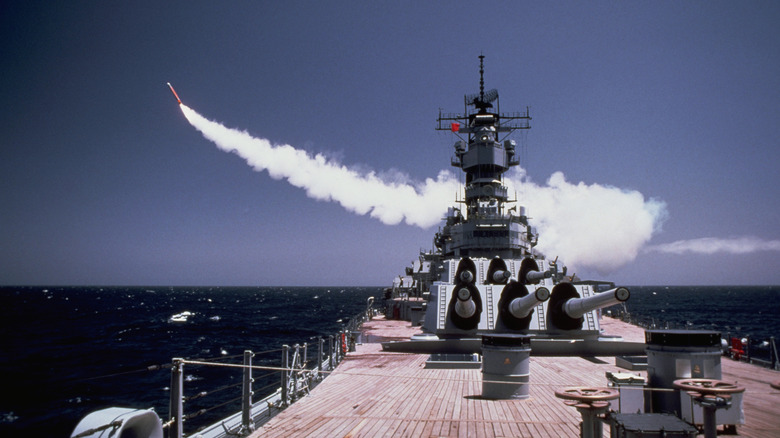
Tomahawk missiles have been world famous since the first Gulf War in 1991 when the United States used the missile against Saddam Hussein's forces in Iraq and Kuwait. Since then, the missile system has been used in nearly every conflict the United States has been involved in, including recent strikes against Houthi rebels in Yemen. Given the weapon's ubiquity, it's worth exploring what exactly a Tomahawk missile is. The United States Navy reports that over 2,300 Tomahawks have been deployed in combat, with that number increasing by the day.
According to the Missile Defense Project from the Center for Strategic and International Studies, the Tomahawk (full name Tomahawk Land Attack Missile) has been in service since 1983 and were first developed for the United States Navy starting in 1972. It was designed to be launched from ships or submarines and was, from the outset, made with nuclear payloads in mind. However, nuclear-armed Tomahawks have not been used in combat and are currently deactivated.
Slow and steady
The Tomahawk missile itself is a 20.3 foot long craft with a wingspan of eight and a half feet, and it weighs 3,330 pounds with all of its components. It's powered by both a rocket booster and turbofan jet engine made by Williams International. According to PBS, the rocket booster engine launches the Tomahawk in the air (hence all the smoke you may see in news broadcasts or photos you see of the missile) and then its jet engine takes the missile the rest of the way to its target.
Despite being powered by rockets and a jet engine, the Tomahawk missile itself isn't that fast, at least comparatively. It reportedly travels at a speed of around 550 miles per hour. An F-16 fighter jet tops out at 1,500 miles per hour and the much larger Minuteman III ballistic missile can reach speeds of up to 15,000 miles per hour. Supposedly, the Tomahawk's relatively low speed helps it avoid radar systems more efficiently. Additionally, it flies at an altitude of between 100 and 300 feet, much lower than conventional fighter aircraft.
Range and power
The actual payload of the Tomahawk can consist of a number of different munitions. But the primary warhead of the Tomahawk is a 1,000-pound high explosive charge. It can also carry cluster munitions consisting of small bomblets, similar to the ATACMS currently used in Ukraine . For explosive force, Tomahawks were more than enough to disable runways or sink ships.
The exact guidance system and navigational dynamics of the Tomahawk missile are classified. However, it is known that it can use GPS or inertial guidance systems to hit the target. Additionally, the U.S. Navy states that up to 15 targets can be pre-programmed for missile salvos. The Tomahawk is capable of "loitering," meaning that, provided the missile has enough fuel, it can fly around in circles to relay information or wait for the right target. It has a range of around 1,500 miles, meaning that the ship or submarine launching the missile is well out of harm's way. It is accurate to within 10 meters.
The Tomahawk's combat history
The Tomahawk is primarily made by Raytheon Missile Systems. According to budget data from the United States Marine Corps from 2022, each Tomahawk costs around $2 million. As of now, the United States and the United Kingdom are the only countries to deploy Tomahawk missiles, although Australia and Japan have put out bids to purchase Tomahawks.
The U.S. Navy states that 140 total craft are capable of launching Tomahawks. That number consists of Ohio-class submarines, Arleigh Burke-class destroyers, and more. The United States Army has also tested launching Tomahawks from ground-based platforms. The USS Missouri, a World War II-era battleship and the very last of its kind, was fitted to fire Tomahawks during the opening salvos of the First Gulf War. It fired a total of 28 cruise missiles, in addition to its 16-inch deck guns.
The submarines USS Louisville and USS Pittsburgh launched Tomahawks in 1991 at targets in Iraq and became the first submarines to fire Tomahawks while submerged.
Several decades of service
Outside of the Gulf War, Tomahawks were used to attack Iraq several more times in the 1990s, against Bosnian targets in 1995, during NATO actions against Yugoslavia, and during the engagements against Afghanistan after 9/11. More recently, Tomahawks saw use in Libya as part of Operation Odyssey Dawn, ISIS in Syria experienced the effects of Tomahawks, and Syrian chemical weapons facilities used by despot Bashar Al-Assad were struck by Tomahawks in 2017. In 2024, both American and British forces launched Tomahawks against Houthi rebels after the rebel group attacked shipping lanes and US-flagged vessels in the Red Sea.
Raytheon reports that the Tomahawk missile could stay in service until at least 2035. By that time, the cruise missile will have eclipsed 50 years of service. With its long range, ability to be launched practically anywhere in the world from above or below the waves, and its accuracy, the Tomahawk has proved literally thousands of times that it is a vital part of the arsenals of the U.S. Navy and the Royal Navy.
This Is Not Your Father’s Tomahawk Cruise Missile
The new Block V can run down enemy ships and blast them with a half-ton high explosive warhead.
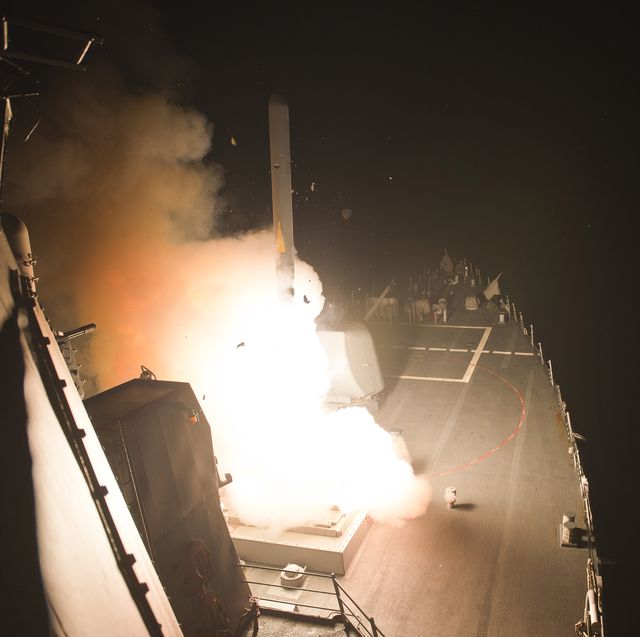
Gear-obsessed editors choose every product we review. We may earn commission if you buy from a link. Why Trust Us?
- The new missiles can attack enemy ships at sea or land targets with a new multi-effect warhead.
- The Tomahawk design is nearly half a century old but with the help of rolling upgrades has remained a viable weapon system.
The Tomahawk cruise missile, one of the oldest missiles in U.S. military service, is set to receive a new set of capabilities designed to help keep potential enemies in check.
➡ You love badass military tech. So do we. Let's nerd out over it together.
The missile’s new Block V configuration will include both new anti-shipping and land attack variants, boosting the capabilities of the U.S. Navy surface warships that carry them.
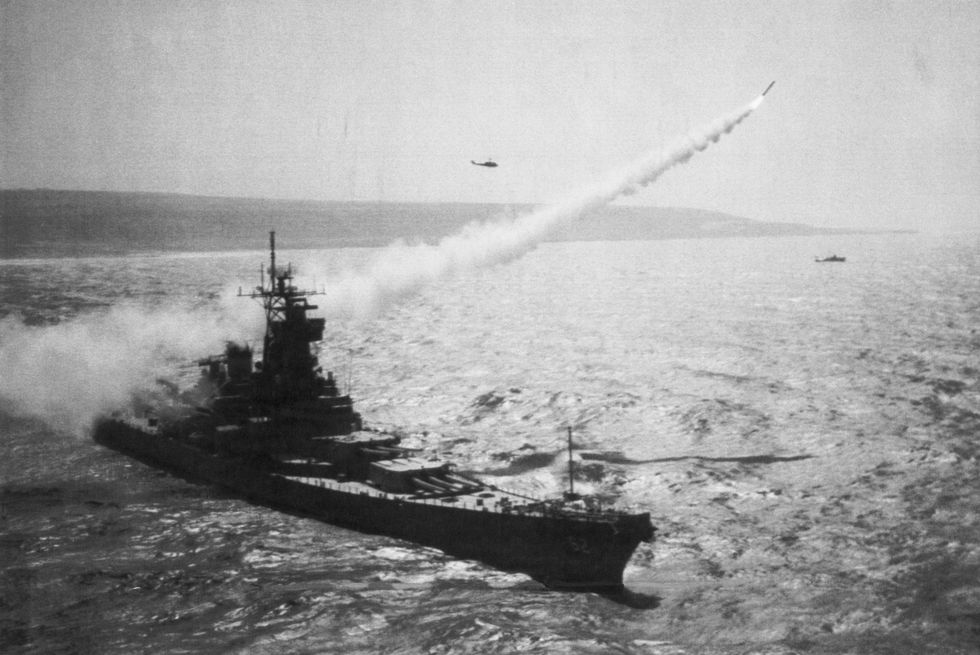
The Tomahawk is one of the most effective missiles in the Pentagon’s history. The missile, which General Dynamics first designed in the 1970s, was one of the first truly effective cruise missiles. Unlike traditional missiles that use rocket motors, fly high altitudes, and travel at Mach 2+ speeds, cruise missiles use turbojet engines, fly at low altitudes, and travel at subsonic speeds.
Most missiles are designed to sprint to their targets; Tomahawk is designed to run a marathon. Engineers chose a liquid fuel-sipping turbojet engine because it enabled greater range than a rocket engine of roughly the same size. A slower speed also makes low altitude flight more viable, which in turn makes the missile much more difficult to detect by radar. Today, most advanced countries operate similar low-flying subsonic missiles, including Russia, China, France, and South Korea.

Despite its age, the Tomahawk has stayed in the game through a series of progressive upgrades. The original Block I version included both nuclear-tipped and anti-ship versions of the missile. Block II introduced land attack capabilities, like those demonstrated during the 1991 Gulf War, with missiles striking Iraqi Air Force airfields and daytime targets across the Iraqi capital of Baghdad. Block III added GPS, eliminating a time-consuming programming system that required 80 hours to plot a missile’s course as well as a loitering capability.
Block IV Tomahawks added more features, including the ability to be re-routed to new targets in mid-flight. Block IV missiles also feature a camera and datalink, allowing a missile to send imagery back to friendly forces. If a Tomahawk discovers its target already struck or civilians are crowding the target area, the missile can be re-routed to destroy something else.
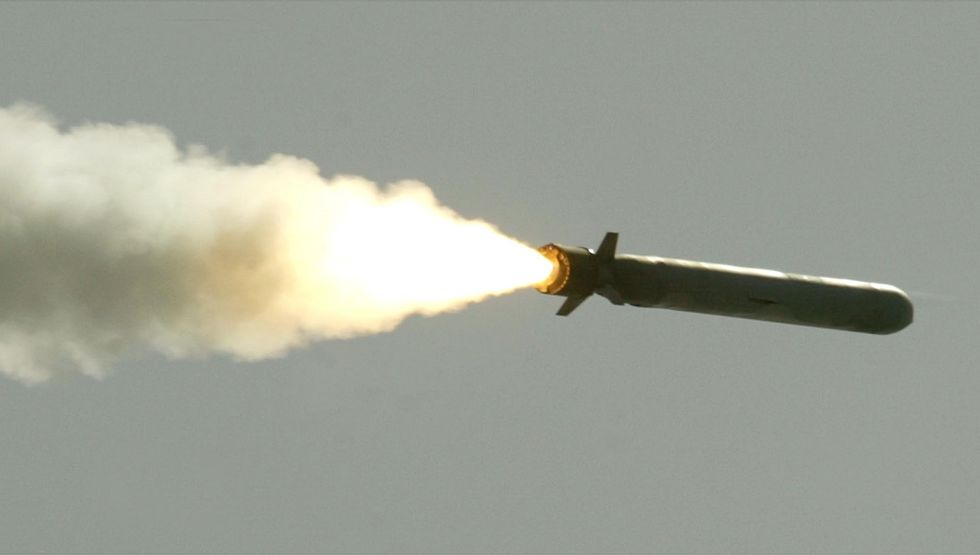
Now, Block V is where it gets really interesting.
The newest variant adds upgraded navigation and communications gear to older Tomahawks, electronics that, according to Defense News , make it easier to work through electronic warfare jamming and more difficult for enemy radars to detect. That’s important, because once detected, subsonic cruise missiles are relatively easy to shoot down. Block V then forks into two missiles, Block Va and Block Vb.
The Coolest Military Toys
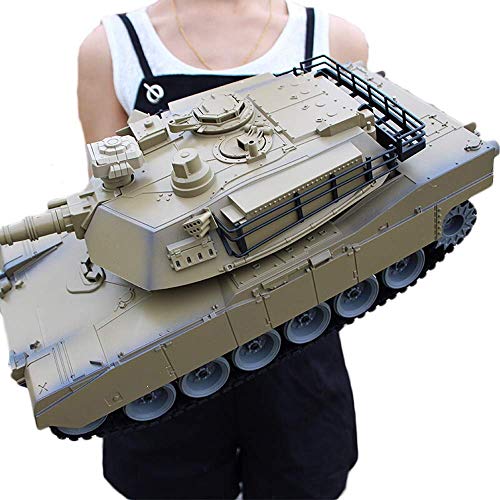
GRTVF 1:18 Scale RC Tank German Tiger Panzer

Tletiy Soviet T34 Mini RC Tank
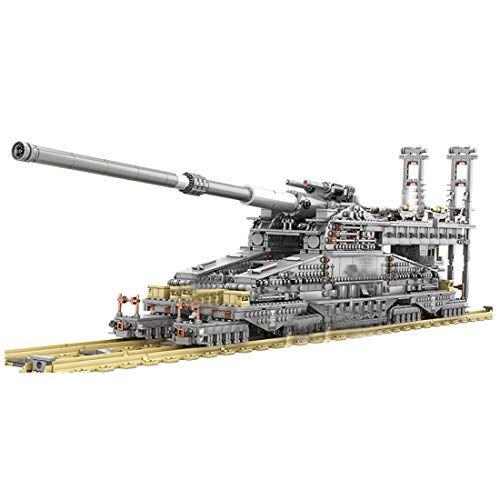
PeleusTech 3,846-Piece Model WWII German Dora Cannon

Big Bang 9-Inch 6F Light Field Vintage Cannon
Block Va essentially turns the cruise missile into an anti-ship missile. Also known as Maritime Strike Tomahawk, Block Va adds a seeker kit, including sensor, giving it the ability to strike moving targets at sea at ranges in excess of 1,000 miles. It’s not clear if Block Va can still strike land targets.
Block Vb is more oriented toward striking land targets with the new Joint Multiple Effects Warhead (MEWS). The weapon is a bit mysterious, but it seems to be a 1,000-pound warhead capable of striking both surface and underground hardened targets, including “integrated air defense systems and weapons of mass destruction” .
The great thing about Block V is that, unlike the Navy’s current anti-ship missile, it doesn’t need separate launchers. Block Vs will fit in any Mk. 41 vertical launch system silo—the same silo that currently carries Standard anti-air missiles, the SM-3 missile interceptor, Evolved Sea Sparrow interceptor missiles, and vertical launch anti-submarine rockets.
Today’s guided missile cruisers carry 122 silos, while destroyers carry between 90 and 96 silos. Theoretically, a cruiser could carry up to 122 Block Va missiles, though a more rounded mix of all of the above is preferred. Block V will also arm U.S. Navy submarines.
Like a lot of weapons in America’s arsenal, the Tomahawk missile is old—at least in concept. What started out as a nuclear-capable missile can now hunt down warships at 1,000 miles and attack hardened underground targets. The missile’s ability to adapt with the times, take on new roles, and reinvent itself means it will be a potent weapon system for easily another decade to come.
Now Watch This:
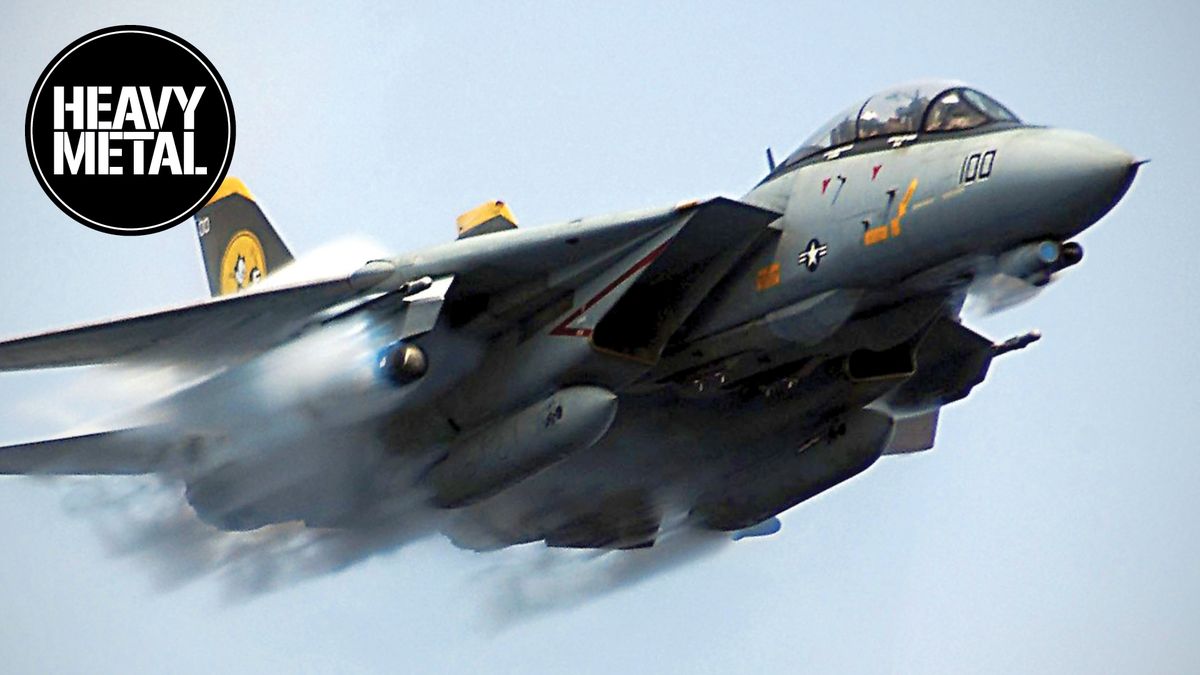
Kyle Mizokami is a writer on defense and security issues and has been at Popular Mechanics since 2015. If it involves explosions or projectiles, he's generally in favor of it. Kyle’s articles have appeared at The Daily Beast, U.S. Naval Institute News, The Diplomat, Foreign Policy, Combat Aircraft Monthly, VICE News , and others. He lives in San Francisco.
.css-cuqpxl:before{padding-right:0.3125rem;content:'//';display:inline;} Weapons .css-xtujxj:before{padding-left:0.3125rem;content:'//';display:inline;}

US Army Accepts Delivery of First M10 Assault Gun

A New Hypersonic Missile Will Give the F-35 Fangs

The U.S. Has Built an Unstoppable Microwave Weapon

The Army Has a Plan to Kill Drones

Army: The Days of Towed Artillery Are Over

The US Army Has Deployed Lasers to a Combat Zone

The Manhattan Project's Deadly Legacy in St. Louis
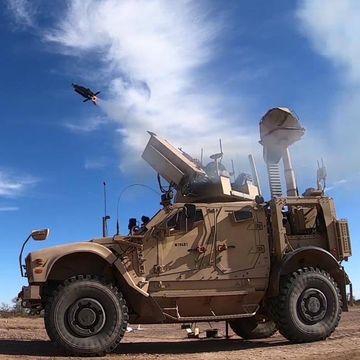
The Army Is Clearing Out for Coyote Drone Hunters
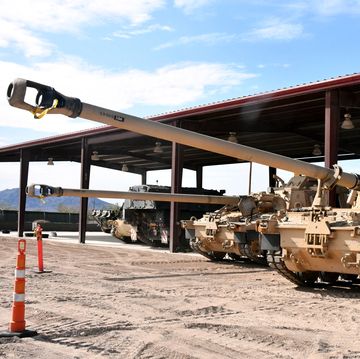
This Long-Range Howitzer Has Met Its Achilles Heel

Inside the Development of America's New Nuke
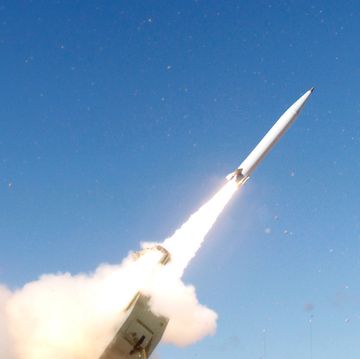
What’s in the Pentagon’s 2025 Defense Budget
- Skip to main content
- Skip to primary sidebar
- Skip to footer
Center for Arms Control and Non-Proliferation
April 27, 2017
Fact Sheet: Ballistic vs. Cruise Missiles

Ballistic missiles are powered initially by a rocket or series of rockets in stages, but then follow an unpowered trajectory that arches upwards before descending to reach its intended target. Ballistic missiles can carry either nuclear or conventional warheads.
There are four general classifications of ballistic missiles based on their range, or the maximum distance the missile can travel:
- Short-range: less than 1,000 kilometers (approximately 620 miles), also known as “tactical” ballistic missiles.
- Medium-range: between 1,000 and 3,000 kilometers (approximately 620-1,860 miles), also known as “theater” ballistic missiles.
- Intermediate-range: between 3,000 and 5,500 kilometers (approximately 1,860-3,410 miles)
- Long-range: more than 5,500 kilometers (approximately 3,410 miles), also known as intercontinental or strategic ballistic missiles. Intercontinental ballistic missiles (ICBMs) can fly much further than the minimum range; for example, Russia could hit Chicago with an ICBM launched from the Krasnoyarsk ICBM base, which is located 9,156 kilometers (5,689 miles) away.
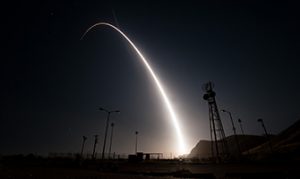
Ballistic missiles have three stages of flight:
Boost Phase begins at launch and lasts until the rocket engine(s) stops firing and the missile begins unpowered flight. Depending on the missile, boost phase can last three to five minutes. Most of this phase takes place in the atmosphere.
Midcourse Phase begins after the rocket(s) stops firing. The missile continues to ascend toward the highest point in its trajectory, and then begins to descend toward Earth. This is the longest phase of a missile’s flight; for ICBMs, it can last around 20 minutes. During midcourse phase, ICBMs can travel around 24,000 kilometers per hour (15,000 miles per hour).
Terminal Phase begins when the detached warhead(s) reenter the Earth’s atmosphere and ends upon impact or detonation. During this phase, which can last for less than a minute, strategic warheads can be traveling at speeds greater than 3,200 kilometers per hour (1,988 miles per hour).
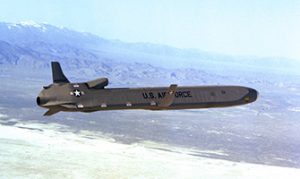
Cruise missiles remain within the atmosphere for the duration of their flight and can fly as low as a few meters off the ground. Flying low to the surface of the earth expends more fuel but makes a cruise missile very difficult to detect.
Cruise missiles are self-guided and use multiple methods to accurately deliver their payload, including terrain mapping, global positioning systems (GPS) and inertial guidance, which uses motion sensors and gyroscopes to keep the missile on a pre-programmed flight path. As advanced cruise missiles approach their target, remote operators can use a camera in the nose of the missile to see what the missile sees. This gives them the option to manually guide the missile to its target or to abort the strike.
To learn about missile defense, check out our fact sheet .
Sources: Department of Defense, Missile Defense Agency, Federation of American Scientists .

820 1st Street NE, Suite LL-180 Washington, D.C. 20002 Phone: 202.546.0795
Advertisement
How Missiles Work
- Share Content on Facebook
- Share Content on LinkedIn
- Share Content on Flipboard
- Share Content on Reddit
- Share Content via Email
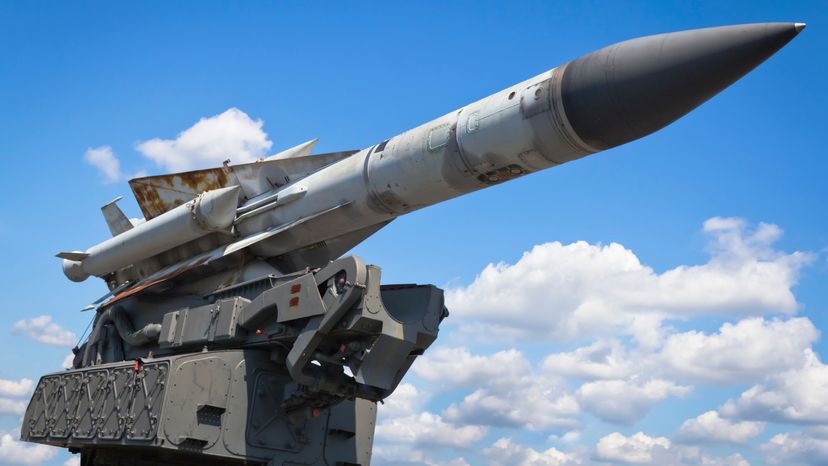
The military uses missiles as one of its favorite weapons, because a missile allows a person to launch a weapon many miles away from the target.
At HowStuffWorks you can learn how all of these different types of missiles work:
- How Stinger Missiles Work
- How Cruise Missiles Work
- How Patriot Missiles Work
- How Sidewinder Missiles Work
- How Apache Helicopters Work - discusses Hellfire Missiles
- How Missile Defense Systems Will Work
- See also: How Bombs Work
Please copy/paste the following text to properly cite this HowStuffWorks.com article:
Why it’s so hard to defend against cruise missiles
A recent conference raises the question: What kind of threat does this type of weapon pose to the United States?
By Kelsey D. Atherton | Published Jul 25, 2022 7:00 AM EDT
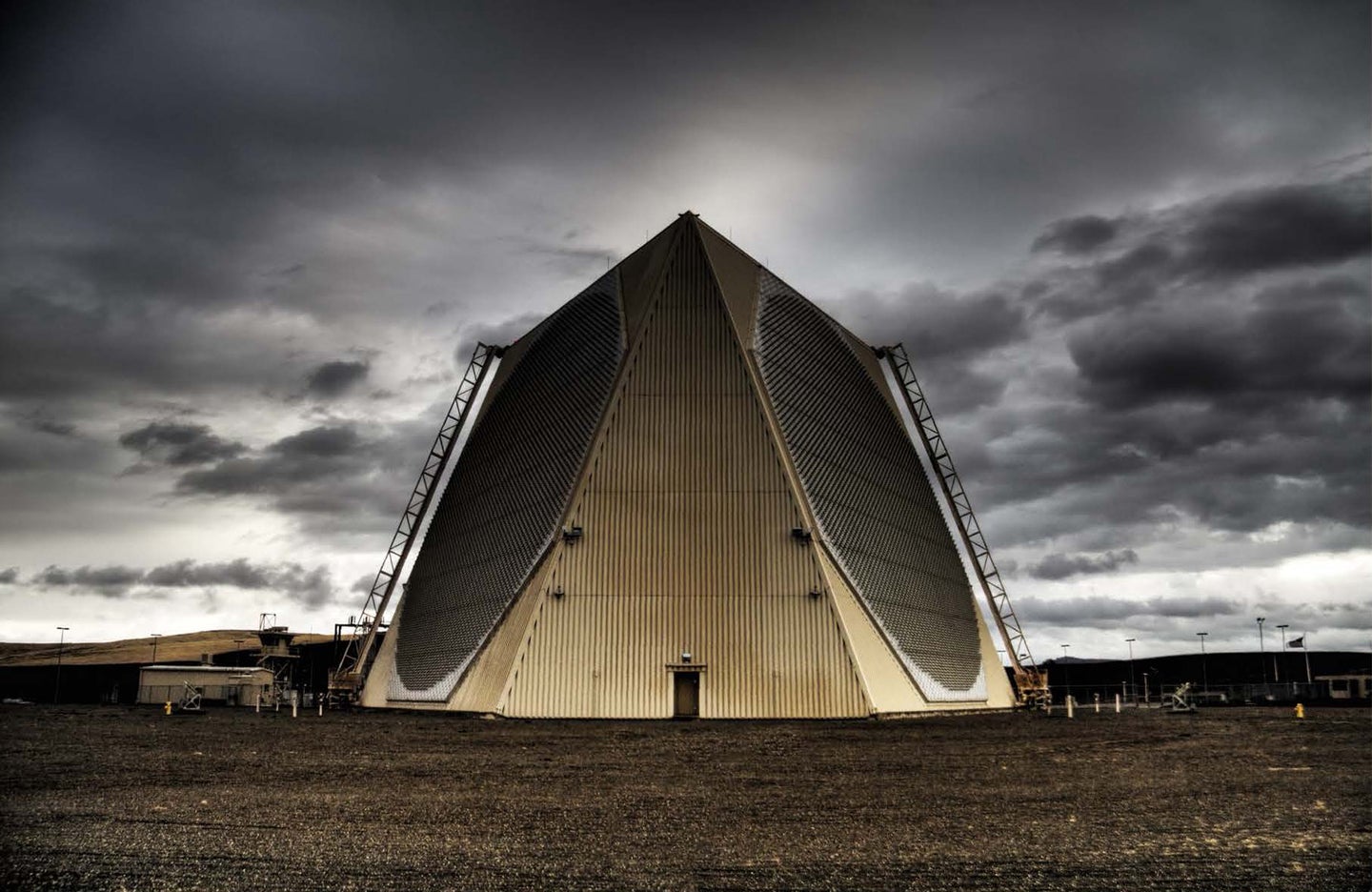
On July 14, the Center for Strategic and International Studies in Washington, DC held a one-day conference premised on a specific threat: What if, in the future, war comes to the United States via cruise missile? Pointing to new developments in cruise missile technology, and the limitations of existing early warning systems that are focused on the high arcing trajectories of ballistic missiles, the CSIS conference and accompanying report suggests that to defend the continental United States from such a threat, the military should adapt and deploy the kind of cruise missile defenses presently used as regional weapons.
Unlike ballistic missiles, which arc up into space before traveling back down towards earth, cruise missiles fly close to the ground, making it hard for radar on the ground that’s pointed up at space to see them.
The perceived threat from new cruise missiles is driven by tech developments occurring across the globe, as new materials, better aerodynamics, and sophisticated sensors and guidance systems make possible the fielding of weapons, like hypersonic missiles , that had mostly been just theoretical decades ago.
For the United States, the development of long-range bombers in the 1940s, followed by the development of intercontinental ballistic missiles, shattered the notion that the enormous distances of the Atlantic and Pacific oceans were enough to protect the continental US from direct attack. (During World War II, US territories in the Pacific came under direct attack, but the only long-range assault on the 48 states came in the form of incendiary-carrying balloons launched by Japan into the jet stream and carried over to the US.)
With atomic and then thermonuclear payloads, bombers and long-range missiles threatened devastation on an unprecedented scale, and the United States built an elaborate system of early warning sensors focused on detecting early signs of launch, and expanded its first-in-the-world nuclear arsenal to deter attack. North American Aerospace Defense Command (NORAD) is run by both Canada and the United States, and maintains a series of radars and other sensors designed to detect early attacks across the Arctic or elsewhere. (Every December, NORAD highlights its existence by tracking Santa Claus, turning a system designed to detect oblivion into a kid-friendly Christmas tradition .)
At the conference held by CSIS, the threat from cruise missiles was discussed as a way that other countries could attack the United States that is hard to detect by employing existing, ICBM-focused measures. It is also considered hard to deter through threat of nuclear retaliation, operating on the assumption that if a cruise missile with a conventional warhead destroyed a building or killed people in the United States, the President would not immediately respond with a nuclear strike.
“You know, our adversaries are building diverse, expansive ranges of modern offensive missile systems, and we see them – we see them in the news every day,” Stan Stafira, Chief Architect of the Pentagon’s Missile Defense Agency, told the panel. “They’re capable of maneuvering in the midcourse and the terminal phases of their flight, like maneuvering reentry vehicles, multiple independent reentry vehicles, hypersonic glide vehicles, and cruise missiles.”
Part of the broader appeal of hypersonic weapons to nations like Russia, China, and the United States is that the speed and trajectories of the missiles make them harder to detect than ICBMs. The ballistic arc of ICBMs means the launch is visible to radar while it is still ascending, once it clears the horizon line. Meanwhile, both hypersonic glide vehicles and hypersonic cruise missiles, which travel at Mach 5 or above, are designed to fly below that radar horizon, with the cruise missile keeping a close trajectory to earth and the glide vehicle flying in the high atmosphere.
“I want to state that we absolutely believe that nuclear deterrence is the foundation of homeland defense,” said Lieutenant General AC Roper, deputy commander of Northern Command, the part of the US military responsible for North America. “However, we also must have credible deterrence options below the nuclear thresholds, options which allow for a balanced approach of deterrence by denial and deterrence by punishment or cost imposition.”
Deterrence, at its most straightforward, is a strategy of making a big threat on a condition: One country publicly declares it will launch nukes at another if it launches nukes at it, with the intended effect that neither country launches nukes. But because the payload of a cruise missile—it could be nuclear or conventional, unlike ICBMs, which are always nuclear—is unlikely to be known until impact, generals like Roper would prefer to have a range of weapons with which to respond.
Missile defense is one of those options, and the US already employs a few forms. Part of any missile defense system is the sensors, like specially focused radar, that can detect incoming attacks, and then track those weapons as they travel. These radars then send that tracking information to interceptors, which are missiles launched to fly and destroy the incoming attacking missile. Shooting missiles at other missiles is a hard problem because an incoming threat arrives at great speed, and because the cost calculus can favor an attacker. Interceptors, like shorter-ranged Patriot missiles or longer-ranged ballistic interceptors , are often more expensive than the missiles they are intercepting. And unlike interceptors, which have to hit precisely to work, missiles launched in attack can deploy decoys or countermeasures to redirect interceptors away, or can instead be fired in a greater volume, overwhelming interceptors through sheer numerical advantage.
“The resulting 20-year cost to provide even a light defense of a vast area ranged from $77 billion to $466 billion,” reads the CSIS report , citing an analysis from the Congressional Budget Office studying a range of cruise missile defense options. “The considerable cost variation is due to alternative combinations of sensors and interceptors and varying desired warning times of 5 or 15 minutes.”

Kelsey D. Atherton is a military technology journalist who has contributed to Popular Science since 2013. He covers uncrewed robotics and other drones, communications systems, the nuclear enterprise, and the technologies that go into planning, waging, and mitigating war.
Like science, tech, and DIY projects?
Sign up to receive Popular Science's emails and get the highlights.

A game of numbers: How air defense systems work and why Ukraine is eager for more protection
Professor of Aerospace Engineering Sciences, University of Colorado Boulder
Disclosure statement
Iain Boyd receives funding from the U.S. Department of Defense, the U.S. Department of Energy, NASA, Lockheed-Martin, and L3-Harris.
University of Colorado provides funding as a member of The Conversation US.
View all partners
Ukraine has received a broad array of military supplies from the U.S. and other allies. Recently, Ukrainian President Volodymyr Zelenskyy made an urgent plea specifically for additional air defense resources from the West in response to increased air attacks by Russia .
To understand Zelenskyy’s emphasis on air defense, it’s important to look at the types of air weapons that Ukraine faces and how air defenses work to counteract those threats. It’s also important to understand why this type of warfare is all about the number of assets each side has at its disposal.
Increased air attacks
On Oct. 10, 2022, Russia launched a large barrage of airborne weapons against a variety of targets in Ukraine. The types of weapons involved in the attack included short-range ballistic missiles and cruise missiles.
Ballistic missiles are accelerated by rockets from the ground or from aircraft, tend to follow a predictable path and are somewhat easier to track. Cruise missiles carry a propulsion system that allows them to maintain speed and fly more unpredictable flight paths, including trajectories that are close to the ground. They are much more difficult to detect, track and shoot down.
Then, on Oct. 17, Russia launched a barrage of explosive drones at Ukraine’s capital city, Kyiv . Explosive drones, known as loitering munitions, tend to be small weapons that are difficult to defend against. By circling overhead, they are able to surveil a region of interest, gathering information before identifying a specific target to attack. Russia has acquired explosive drones from Iran , according to U.S. officials.
Air defense systems
The defense against all such air threats involves an integrated system of several elements.
Early warning radars located at Ukraine’s borders first detect the approach of missiles. These weapons are further tracked along their flight trajectories by a dispersed network of additional radars. The primary defensive countermeasure against ballistic and cruise missiles involves surface-to-air missiles (SAMs) : You destroy a missile using a missile. This is no easy feat because the SAM must track, home in on and hit a high-speed target that may be changing direction.
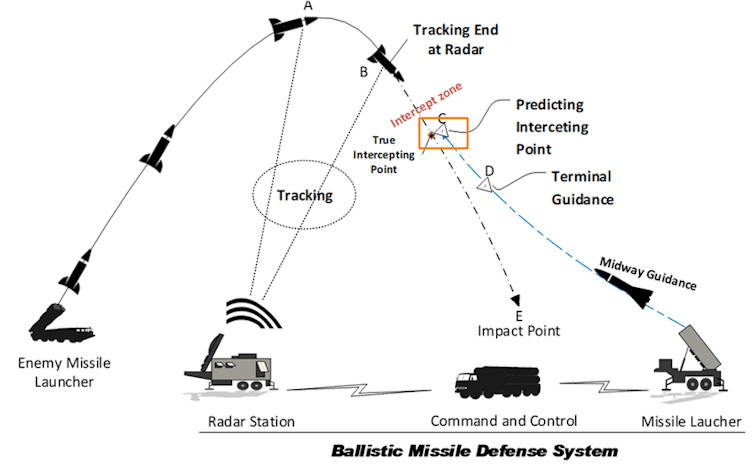
In the U.S., key strategic assets such as the White House are protected against aerial attack by the National Advanced Surface-to-Air Missile System (NASAMS) . NASAMS was designed to counteract a variety of incoming threats, including cruise missiles, aircraft and drones. Each NASAMS contains 12 interceptor SAMs. No information is available publicly on its effectiveness. NASAMS is one of the options being considered by the U.S. to help support Ukraine.
Another notable example of an air defense system is the Israeli Iron Dome . The system is designed to defend against rockets and artillery shells launched from up to 155 miles (250 kilometers) away. Each Iron Dome missile battery consists of three to four missile launchers, each with up to 20 interceptor SAMs.
The system is reported to have a 90% kill rate for rockets launched against Israel. Veteran national security correspondent Mark Thompson described Iron Dome as possibly the most effective missile defense system the world has seen .
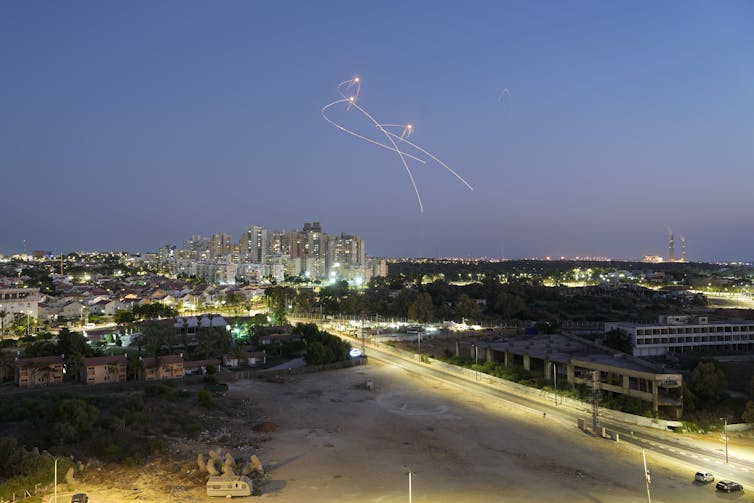
Both NASAMS and Iron Dome are reported to be effective against drones. However, SAMs are an expensive way to defend against such low-cost targets, and they could be overwhelmed by large numbers of drones. Directed energy weapons such as high energy lasers are being developed and deployed to provide a potentially more cost-effective approach to neutralizing low-cost drones.
A numbers game
The significance of the plea by Zelenskyy for additional air defense systems can be understood in the context of a numbers game. Different air defense systems have a range of effectiveness against different aerial threats. However, none of the defense systems is 100% effective.
Moreover, an adversary can significantly reduce the effectiveness of air defense by launching salvos of multiple weapons simultaneously. Therefore, an attacker can always overwhelm a defender if the attacker has more attack missiles than the defender has defensive missiles. Conversely, a sufficient number of defensive systems may cause an attacker to stop firing altogether. It becomes a war of attrition, with the winner being the side with the most missiles.
Ukraine likely has sufficient air defenses to protect strategic military targets such as command and control centers and ammunition dumps. They do not have coverage of many other key assets such as transportation hubs and power and water facilities, the types of targets Russian forces have been targeting in recent days.
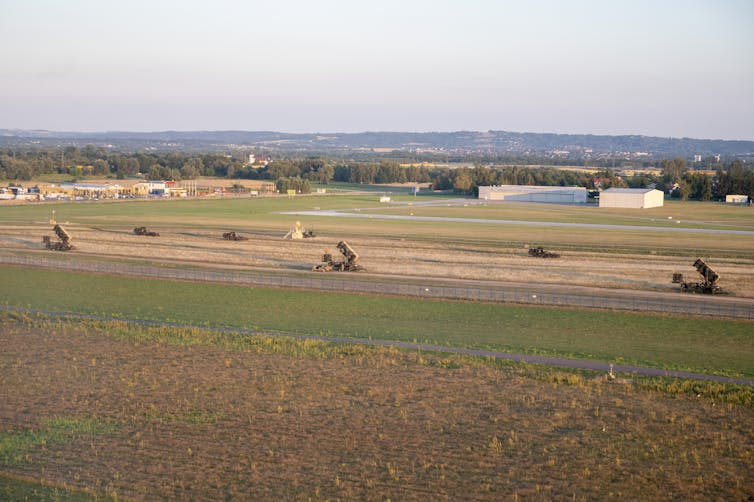
Should the West agree to provide significant numbers of air defense systems to Ukraine, it could significantly change the course of the conflict. At some point, Russia will have to confront the finite depth of its missile stockpile. The number of remaining Russian high-precision missiles is already reported to be running low .
Without the ability to wear down and demoralize Ukraine through airstrikes, Russia would be faced with the much more daunting and drawn-out prospect of relying solely on ground forces to grind out its objectives.
- Ballistic missiles
- Cruise missiles
- Russia-Ukraine
- Russian invasion

Scheduling Analyst

Assistant Editor - 1 year cadetship

Executive Dean, Faculty of Health

Lecturer/Senior Lecturer, Earth System Science (School of Science)

Sydney Horizon Educators (Identified)
Watch CBS News
How air defense systems work and why Ukraine is eager for more protection
By Iain Boyd
October 18, 2022 / 3:09 PM EDT / The Conversation
Iain Boyd is a professor of aerospace engineering sciences at University of Colorado—Boulder .
Ukraine has received a broad array of military supplies from the U.S. and other allies. Recently, Ukrainian President Volodymyr Zelenskyy made an urgent plea specifically for additional air defense resources from the West in response to increased air attacks by Russia .
To understand Zelenskyy's emphasis on air defense, it's important to look at the types of air weapons that Ukraine faces and how air defenses work to counteract those threats. It's also important to understand why this type of warfare is all about the number of assets each side has at its disposal.
Increased air attacks
On Oct. 10, 2022, Russia launched a large barrage of airborne weapons against a variety of targets in Ukraine. The types of weapons involved in the attack included short-range ballistic missiles and cruise missiles.
Ballistic missiles are accelerated by rockets from the ground or from aircraft, tend to follow a predictable path and are somewhat easier to track. Cruise missiles carry a propulsion system that allows them to maintain speed and fly more unpredictable flight paths, including trajectories that are close to the ground. They are much more difficult to detect, track and shoot down.
Then, on Oct. 17, Russia launched a barrage of explosive drones at Ukraine's capital city, Kyiv . Explosive drones, known as loitering munitions, tend to be small weapons that are difficult to defend against. By circling overhead, they are able to surveil a region of interest, gathering information before identifying a specific target to attack. Russia has acquired explosive drones from Iran , according to U.S. officials.
Air defense systems
The defense against all such air threats involves an integrated system of several elements.
Early warning radars located at Ukraine's borders first detect the approach of missiles. These weapons are further tracked along their flight trajectories by a dispersed network of additional radars. The primary defensive countermeasure against ballistic and cruise missiles involves surface-to-air missiles: You destroy a missile using a missile. This is no easy feat because the SAM must track, home in on and hit a high-speed target that may be changing direction.
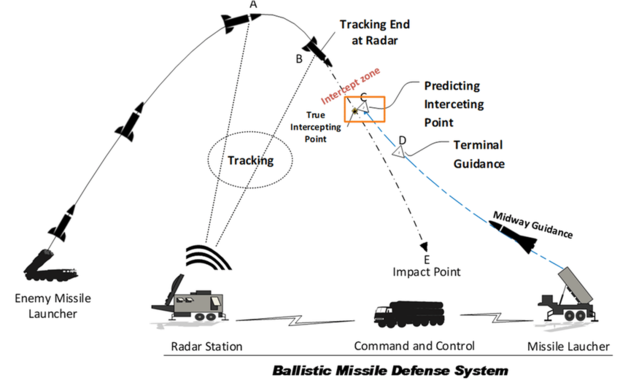
In the U.S., key strategic assets such as the White House are protected against aerial attack by the National Advanced Surface-to-Air Missile System (NASAMS) . NASAMS was designed to counteract a variety of incoming threats, including cruise missiles, aircraft and drones. Each NASAMS contains 12 interceptor SAMs. No information is available publicly on its effectiveness. NASAMS is one of the options being considered by the U.S. to help support Ukraine.
Another notable example of an air defense system is the Israeli Iron Dome . The system is designed to defend against rockets and artillery shells launched from up to 155 miles (250 kilometers) away. Each Iron Dome missile battery consists of three to four missile launchers, each with up to 20 interceptor SAMs.
The system is reported to have a 90% kill rate for rockets launched against Israel. Veteran national security correspondent Mark Thompson described Iron Dome as possibly the most effective missile defense system the world has seen .
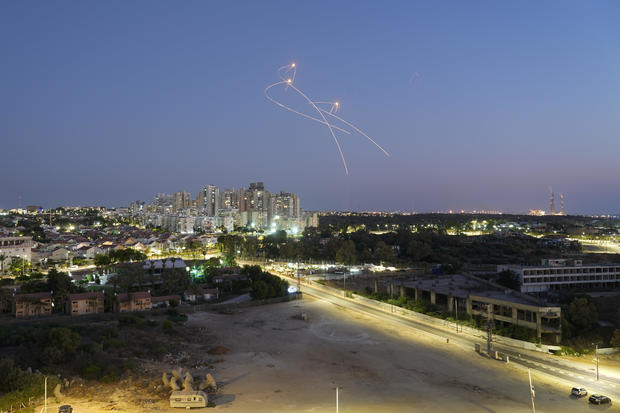
Both NASAMS and Iron Dome are reported to be effective against drones. However, SAMs are an expensive way to defend against such low-cost targets, and they could be overwhelmed by large numbers of drones. Directed energy weapons such as high-energy lasers are being developed and deployed to provide a potentially more cost-effective approach to neutralizing low-cost drones.

A numbers game
The significance of the plea by Zelenskyy for additional air defense systems can be understood in the context of a numbers game. Different air defense systems have a range of effectiveness against different aerial threats. However, none of the defense systems is 100% effective.
Moreover, an adversary can significantly reduce the effectiveness of air defense by launching salvos of multiple weapons simultaneously. Therefore, an attacker can always overwhelm a defender if the attacker has more attack missiles than the defender has defensive missiles. Conversely, a sufficient number of defensive systems may cause an attacker to stop firing altogether. It becomes a war of attrition, with the winner being the side with the most missiles.
Ukraine likely has sufficient air defenses to protect strategic military targets such as command and control centers and ammunition dumps. They do not have coverage of many other key assets such as transportation hubs and power and water facilities, the types of targets Russian forces have been targeting in recent days.
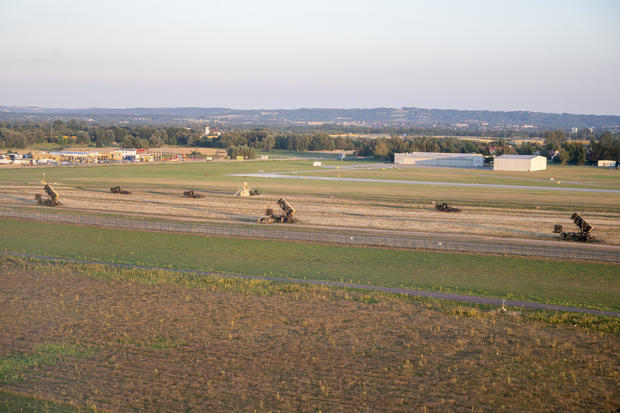
Should the West agree to provide significant numbers of air defense systems to Ukraine, it could significantly change the course of the conflict. At some point, Russia will have to confront the finite depth of its missile stockpile. The number of remaining Russian high-precision missiles is already reported to be running low .
Without the ability to wear down and demoralize Ukraine through airstrikes, Russia would be faced with the much more daunting and drawn-out prospect of relying solely on ground forces to grind out its objectives.
This article is republished from The Conversation under a Creative Commons license.
More from CBS News

Democratic leader Jeffries: "Pro-Putin faction" in GOP delayed Ukraine aid

Australian police shoot armed teenager after stabbing attack

Hamas attacks Israel-Gaza border crossing as cease-fire talks fizzle

Rep. Jeffries says House Democrats "governing as if we were in the majority"

Defencyclopedia
The Ultimate Defence Encyclopedia
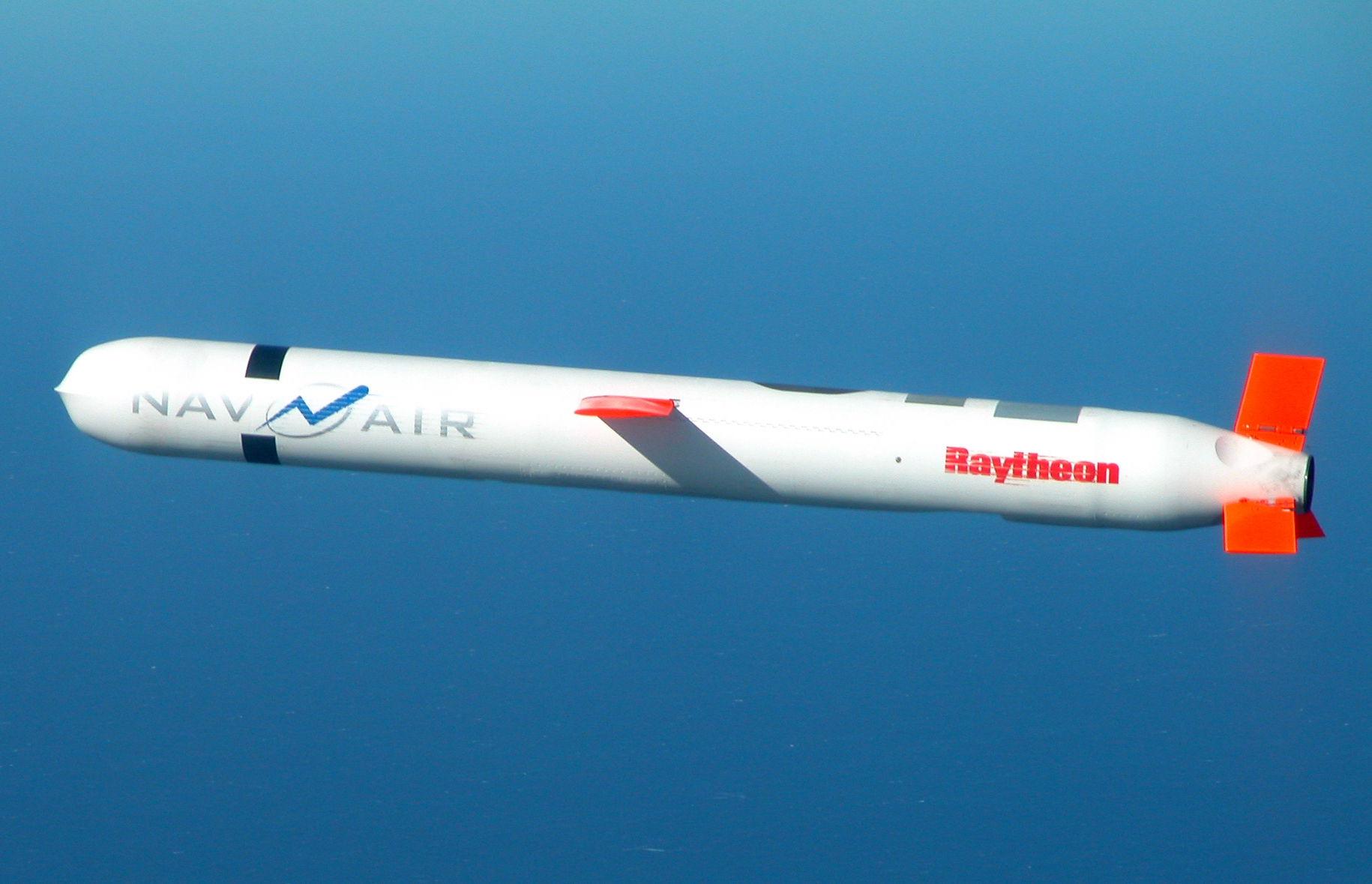
Explained : How Cruise Missiles Work!
Introduction.
I wrote an article last month about the world’s first operational ballistic and cruise missiles. But how exactly do these missiles work? Many have a confusion as to what the exact difference between these two types of missile is, and I intend to make it very clear with this article and illustrations. Since the topic is very vast, I shall deal with cruise missiles in this article in detail. The next article will be about ballistic missiles.
There are two major types of missiles under the category of Surface to Surface Missiles. They are
- Cruise missiles
- Ballistic missiles
CRUISE MISSILES
A cruise missile does exactly what its name says. It cruises, over land or over water. Its working is similar to a jet engine powered airplane. They were developed in the 1930’s and 40’s and first saw action during World War II where the Nazis used the V1 cruise missile. Since then, it has undergone a major evolution into a lethal weapon in the modern battlefield which is very difficult to escape from. Cruise missiles are either subsonic or supersonic depending on their propulsion and design.
There are mainly 2 types of cruise missiles. Land attack missiles (LACM) and Anti-ship missiles (AShM)
Land Attack Missiles

These are the cruise missiles which are designed to hit stationary or moving targets on land. The first cruise missile used in combat, the V1, was a land attack cruise missile. It was guided by primitive mechanisms which reduced its accuracy greatly. Modern land attack missiles have the ability to take out a building by entering through the window or to hit a single vehicle in a convoy with precision. Such is the improvement made over the years.
Nearly all these missiles cost more than a million dollars apiece. But their accuracy and range have made them the preferred choice of attacking heavily defended targets instead of manned combat aircraft. Only USA and Russia have developed long range land attack cruise missiles which have ranges of 1000-3000 km and can be fired from Land, Ships, Aircraft and Submarines. The rest of the world is playing catch up and it’s only recently that many European and Asian countries have acquired long range land attack cruise missiles which can be fired from multiple platforms.

One major user of LACMs is the US. They have fired hundreds of Tomahawk Land Attack Missiles (TLAMs) from ships, submarines and aircraft during the wars in Iraq, Afghanistan and Libya. This tactic, though expensive, proved highly successful as they managed to attack heavily defended targets without risking their fighter pilots. They used the loitering ability and the TV camera of the tomahawk to hit targets with great accuracy and at the optimal time. This made the Tomahawk missile world famous.
Anti-Ship Missiles

Anti-ship missiles are similar in structure to LACMs, but they differ from them in guidance systems and warheads. AShMs were first developed during WW2 but never saw action. But as big guns were becoming obsolete in naval warfare, cruise missiles were preferred as their replacement as they offered a far greater and accurate punch at long distances when compared to the biggest guns in use at that time. The Soviets and Americans built many prototypes, but the Soviets were the first one to equip all their ships with long range anti-ship cruise missiles, most of which were supersonic. The American played catchup for the next 15 years and eventually managed to deploy the Harpoon AShM.
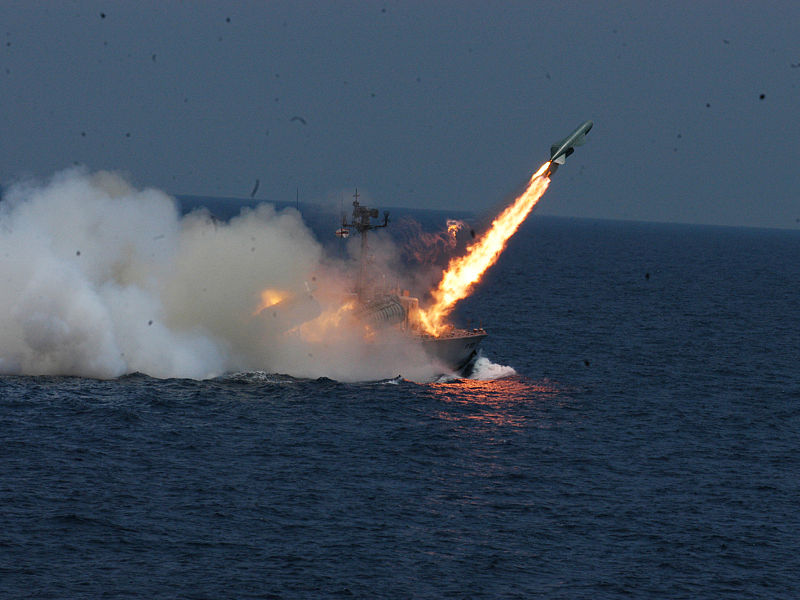
The first Soviet AShM to be popular was the P-15 Styx. This was a cheap to build missile with a powerful 450 kg warhead and a range of 80 km. This missile was built and deployed in thousands and saw extensive action in wars around the world. Since it was supplied to Soviet allies and friends, these countries managed to inflict massive damage on the navies of countries who were using western equipment. The French Exocet missile also saw huge success in several wars which showed how deadly these missiles can be in a war and that a million $ missile can sink a 500 million $ ship.The success of these missiles in conflict increased the demand for Anti-ship cruise missiles and big guns slowly became obsolete.

Jet engines are the main propulsion system for a cruise missile. In jet engines, there are many types which are used on different missiles depending on the requirement.
- Turbofan and Turbojet engines are used in subsonic cruise missiles
- Ramjet and Scramjet engines are used in supersonic and hypersonic cruise missiles
Some supersonic cruise missiles like Klub, make use of a rocket motor in their terminal stage to propel them faster than the speed of sound. But very few make use of rocket motor propulsion as it gives very less range when compared to a jet engine.

Missiles that travel at a speed less than the speed of sound (Mach 1) are called subsonic cruise missiles. The advantage offered by subsonic flight is, longer range. All cruise missiles with a range in excess of 800 km are subsonic. Subsonic missiles are comparatively smaller than their supersonic counterparts and offer very long ranges for a fraction of their size. It is easier to shot down a subsonic cruise missile when compared to a supersonic one,

Missiles that travel faster than Mach 1 qualify as supersonic missiles. These missiles are used excessively by Russia who depend on the speed of these missiles to evade enemy air defenses. The advantage of this high speed is that the enemy has very less time to react when the missile is detected. The high speed also renders several defense systems useless against these missiles. The disadvantage is that you cannot have a long range supersonic missile without it being of extremely large size.

Missiles which travel at speeds in excess of Mach 5 are termed as hypersonic missiles. These missiles are mostly experimental and are currently not deployed for active use unlike supersonic missiles. USA, Russia, India and China are supposed to have hypersonic cruise missiles under development for active deployment.
FLIGHT TRAJECTORY
The flight path followed by cruise missiles depend on their launch platform, guidance systems and the target.
Sea skimming / Terrain Hugging
Anti-ship cruise missiles generally follow a sea skimming profile. This means that the missile flies just a few meters above the water surface. This flight profile makes the missile invisible to enemy radar until it is just round 30 km away from the ship due to the earth’s curvature. Flying low delays its detection by the enemy unless the enemy has an airborne radar. But flying low has its disadvantages as well. Fuel consumption is high when following a sea skimming profile. Range at sea skimming height is 30-40% of the range at high attitude flight.
Land attack missiles generally follow a terrain hugging profile. This means that they closely follow the ups and downs of the terrain and remain hidden from detection by radars due to their low altitude.
Mixed altitude profile

Many cruise missiles follow a mixed trajectory. Once they are launched, they fly at high altitude for optimum range and when they approach their target, they climb down to a few meters altitude and make their final approach towards the target. This offers the range advantage of high altitude flight and the radar evading ability of the sea skimming flight. Many modern cruise missiles follow this flight profile and some of them go supersonic at the terminal sea skimming phase.
High Altitude profile
Some cruise missiles fly exclusively at a high altitude and then dive down towards their target. This flight profile gives a very long range to the missiles as the thin air at high altitudes gives very low resistance to the flight of the missile and reduces fuel consumption of the engine. The disadvantage of this flight profile is that the missile becomes easy to detect and shoot down.
LAUNCH PLATFORMS

Airplanes are very fast and flexible launch platforms for cruise missiles. They are mainly used to fie anti-ship cruise missiles. It is because the aircraft can launch a missile at a target, far from its base or carrier and return back to base within minutes. Other platforms don’t have this much speed. The effectiveness of this platform has been exhibited when Exocet missiles fired from fighter aircraft were able to destroy several British warships during the Falklands war. Large bombers are often used as cruise missile carrier and examples like the Russian Tu-95/160 and the American B-52 can carry around 15-20 cruise missiles and serve as airborne missile batteries.
Ground Vehicles

Trucks and fixed launchers are used to launch cruise missiles on land. Trucks are used extensively because of their mobility and the ability to deploy them at any required place in a conflict. Land attack missiles and Anti-ship missiles are truck based and are used to attack high value enemy ground assets and for shore defense respectively.
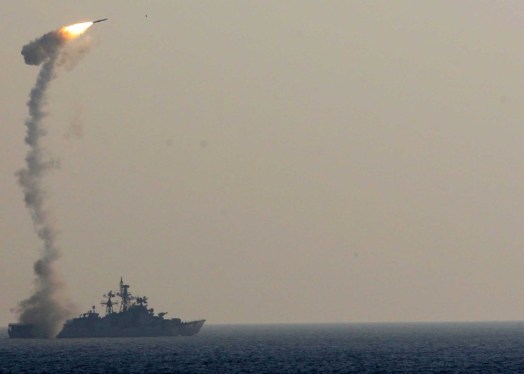
Ships carry a huge number of cruise missiles when compared to land and air based platforms. Anti-ship missiles are carried to sink enemy ships in battle and land attack missiles are carried to attack enemy targets on land, far away from the reach of land based platforms. US Navy is the only one in the world whose entire fleet of destroyers and cruisers can carry long range Tomahawk land attack missiles. The usefulness of this ability was proved in the Gulf war when these ships fired hundreds of cruise missiles at enemy targets on land. Russian Navy ships are generally regarded to have the best anti-ship capability in the world with their supersonic missiles fitted on nearly all their major warships.

Submarines are a very stealthy and dangerous platform for launching cruise missiles because they can fire these missiles while still underwater and then disappear to great depths. This makes it difficult to detect and eliminate this platform in a war. They can fire cruise missiles either rom their torpedo tubes or from Vertical launch cells which are specially fitted. The nuclear powered American Ohio SSGN carries 154 Tomahawk LACMs and the Russian Oscar SSGN carries 24 long range Granit AShMs. Modern subs like Yasen class can carry a mix of LACMs and AShMs in their VLS. These capabilities can prove deadly to the enemy in a conflict.
LAUNCHING TECHNIQUES
Cold launch.
In this technique, the missile is ejected from its launch tube using compressed air. The missile boosters fire once the missile is ejected clear of the ship. Since the missile booster is not ignited in the launch tube itself, the launcher and its surroundings don’t get heated up. Hence the launch is termed as a cold launch. Cold launch is considered to be a safer way of launching missiles as there is no chance of accidental detonation of the missile when it exits the launcher because the missile boosters aren’t ignited till it clears the ship. It is used in Surface to Air missiles (SAM) on ships and extensively for Cruise missiles on submarines.

In this technique, the missile booster ignites when the missile is in its launcher itself. The missile is thrust out of the launcher under its own propulsion. This type of launch gives what is known as a back blast and heats up the launcher and its surroundings. Hence it is termed as a hot launch.
TYPES OF LAUNCHERS
Angled tube launchers.

This type of launcher was the earliest one where the cruise missile was mounted in a missile tube at a particular angle. When the missile was fires, it exited the launcher in the same direction. To fire the missile at a direction other than forward of the launcher, the entire ship had to be turned towards the target. This made it a slow and non-flexible launcher and the angled tubes also occupied a large amount of space. This launcher was extensively used in the 20 th century, and has been replaced by modern vertical launching systems nowadays. But there are modern angled launchers as well. These have missiles which can change direction immediately as they exit the launcher and clear the ship. The advantage of these launchers is that they do not require any deck penetration and ca be easily fitted on any warship with enough deck space .Thus the angled launcher continues to find a place in navies all over the world.
Trainable Box Launchers

This type of launcher was used extensively by the US Navy for firing their cruise missiles. Their frigates and destroyers during the 70s had one or two sets of box launchers which consisted of 8 boxes of cruise missiles each. These launchers could be trained to fire in a required direction unlike tube launchers which are stationary. They were fitted with Harpoon and Asroc missiles. Box launchers were earlier used for Tomahawks as well. Royal Navy also used box launchers for their Exocets. But they were bulky and did not justify the space they occupied and were replaced by vertical launchers.
Vertical launchers

This is currently considered as the holy grail of missile launching systems. It eliminates all the disadvantages of the other 2 types of launchers. It has become very widespread, especially among the top navies in the world owing to its simplicity, flexibility, size, lack of moving parts and the ability to fire missiles faster than any type of launcher. The missiles are just stored in canisters in these vertical launch cells and they don’t need any maintenance.
Vertical launchers generally have different types of launchers for different missiles. But the US were the first to introduce the concept of universal vertical launching system which allows the same launcher to carry a variety of missiles including surface to air missiles. This has been installed on a large number of vessels of various countries. Countries like Russia and China have now developed these UVLS which has gained a lot of popularity owing to its advantage of high flexibility and will be the most popular missile launcher in the future.
GUIDANCE SYSTEMS
The guidance for the cruise missiles is provided by GPS, Inertial guidance system, lasers, TV, Infra-red and radar. Sometimes a combination of two or more systems can be used to provide precision guidance and targeting to the missile.

GPS guidance depends on a GPS or a GLONASS satellite system. A GPS chip in the missile takes directions from an overhead satellite which allows it to hit a stationary target with extreme accuracy. A secondary TV guidance is commonly used with subsonic missiles like Tomahawk to identify the target or re target the missile. This increases the chance of the missile hitting the target.

A laser guidance system is generally used on short range cruise missiles. A laser targeting system paints the target. A laser sensor in the nose of the missile detects the painted target and flies towards it. This targeting system is unreliable as the presence of dust and smoke in the battlefield can mess with the lasers and the painted target may not always be visible to the missile. If laser guidance is used on a long range missile, it is mainly as a secondary and terminal targeting system to hit a target among a group of non-hostiles.

Inertial guidance is something everyone is not familiar with. This is the simple and the earliest guidance system, but it is still used today due to its independence from external support and guidance systems. It consists of a preprogrammed flight path which makes use of motion sensors and gyroscopes to guide the missile near its target and then a secondary and precision targeting like GPS, Infrared or Laser takes over. The missile will be programmed like this for example. Fly at 300 m for 60 seconds, change direction 7 degrees north east, decrease altitude to 100 m and increase speed to 450 knots. This allows the missile to follow a preprogrammed path which it won’t deviate from. Missiles like Brahmos use a combination of Inertial and GPS guidance.

TV guidance is a simple method. It is used alone in case of short range missiles. But it’s used as a terminal guidance system in long range missiles. It consists of a TV camera fitted to the nose of the missile. As the missile approaches the target, the operator can visually identify the target and guide the missile towards it. It’s very useful in situations where you need to pick out targets in civilian areas. Since we can visually identify the hostiles, civilian casualties can be avoided. It’s been used on the AGM 65 maverick, Tomahawk and other missles. This TV guidance system allows Tomahawk to abort an attack in case an irregularity is detected visually which is not possible to be detected by radar.
IR guidance is also one of the earliest guidance systems. The missile which achieved a notorious amount of kills with IR guidance is the Russian Styx. This large missile with its 450 kg warhead and terminal IR guidance was used in several wars in Asia where it achieved a large number of kills. IR guidance is almost outdated if used alone in modern warfare as it can be devoted easily by the use of flares. It also has no way of differentiating friendly targets from hostile ones in crowded areas.
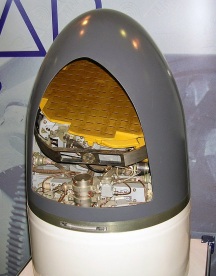
Radar guidance is one of the most popular methods used to guide cruise missiles. Fire control radars are present on all major warships and they illuminate the targets for the missiles to follow and hit. The missiles themselves are often equipped with active or passive radars in order to guide themselves towards the targets beyond the radar horizon. Passive radars on board missiles depend on radar emissions from enemy ships or installations to detect and home in on the target. Whereas active radars in the missiles use their own emissions to locate the enemy ships and structures and home in.

Terrain contour matching is another method of navigation used by cruise missiles. Contour is nothing but the outline of the land and its uneven projections and structures on it. It can be used on LACMs as AShMs don’t have any terrain to follow over water. A terrain map is compared to the current terrain over which the missile is flying using an on board radar altimeter which calculates the current altitude of the missile. The altitude is matched with the terrain contour map and the missile stays on the required path. Sometimes TERCOM is combined with inertial navigation so that the missile can follow its pre-defined path with high accuracy.
Cruise missiles are equipped with different kinds of warheads depending on the type of target they’re supposed to hit. Some of the common warheads are
- High Explosive Incendiary
- High Explosive Fragmentation
- Semi-Armour Piercing
- Submunitions dispenser
Cruise missiles form a major part of modern warfare and have spread extensively to all branches of the military. Their effective use in a modern conflict can change the outcome of war without resorting to nuclear weapons. Improvements in cruise missile technology will see more intelligent, self-maneuvering and hypersonic missiles flood the world market. But whatever happens, cruise missiles will remain one of the most reliable weapons for the foreseeable future.
Enjoyed reading the article ? Rate it below
Share this:
41 replies to “explained : how cruise missiles work”.
- Pingback: Oscar: The carrier killer | battlemachines
- Pingback: Littoral Warfare Ships: Part-1 : Introduction | Defencyclopedia
- Pingback: LITTORAL WARFARE : PART 3 : Russia’s Deadly Fleet | Defencyclopedia
- Pingback: How To Shoot Down Anti-Ship Missiles : Part-1 : Introduction | Defencyclopedia
- Pingback: Quora
- Pingback: Explained – How The US Navy Can Shoot Down The Deadly BrahMos Missile | Defencyclopedia
- Pingback: Top 10 Most Powerful Weapons Of The French Military | Defencyclopedia
how much internal memory did the old cruise ‘tomahawk’ missiles have
That data is classified and not available anywhere. But their internal memory was sufficient to store TERCOM data.
- Pingback: Top 10 Most Powerful Weapons of The Israeli Military | Defencyclopedia
Please explain how ballistic missiles work too:)
- Pingback: Explained : How Jet Engines Work | Defencyclopedia
you are great bro……Reading your articles is everytime joy and informative…..and i dont even read my physics book with same concentration…
Haha. Thank you 🙂
Hey… Admin.. Plz post articles once in 4-5 days..
Sent from my Sony Xperia™ smartphone
Good Point NRP ,why don’t you write Physics and Engineering books..You have a talent to explain the points clearly…
Hi Akshay. It is very tough for me to post articles so often as i will be very busy.So i can only post 2-3 articles per month. 🙂
One thing is forgotten. Exocet missile has ROCKET motor. As so, it does not depend on sea surface proximity as most of others do. Because the closer a missile is to sea surface the greater risk to get some water in missile intake (for any turbofan engines). It makes Exocet able to be extremely close to surface without risk of engine stalling. No intake.
Like Liked by 1 person
Thank you for the information 🙂
The lower missiles fly the harder is to detect them.
- Pingback: Etihad rerouting to avoid Russian missiles? - TeakDoor.com - The Thailand Forum
please note, us armored box launchers were not trainable, they simply elevated to the firing position. they were developed for the battleships. they were “armored” simply to protect the missiles when the main guns were fired. the battleships could only have modern weapon systems that could withstand that shock. thats why they received CWIS but not the NATO launcher they never figured out a good way to protect the sea sparrow missiles. if they had lasted long enough, they might have been candidates for VLS which would have been able to protect any sort of missile form the shock of the main guns.
Thanks for the information.
For info : The picture used for “LASER” chapter is not copyright “Defenseupdate”…It comes from Frogland & I painted it. Thank you.
Hi Daniel. Thanks for the info. I’ll update it and give you the credits.
I have made the changes now. Do check it out.
Nice and detailed information…. Thank you
great article
Good article. A lot of information
Very informative. Thanks
You’re welcome
- Pingback: Modern dünyanın en eski savaş teknolojilerinden: Radarlar – Anasayfa
An article on defenses against terrain-hugging cruise missiles would be interesting.
Good article. Some of this I knew but a lot I did not. Well done.
I really liked your articles. How can I get the latest post related to your writing?
Leave a comment Cancel reply
- Already have a WordPress.com account? Log in now.
- Subscribe Subscribed
- Copy shortlink
- Report this content
- View post in Reader
- Manage subscriptions
- Collapse this bar
A New Pacific Arsenal to Counter China
With missiles, submarines and alliances, the Biden administration has built a presence in the region to rein in Beijing’s expansionist goals.
By John Ismay , Edward Wong and Pablo Robles April 26, 2024
U.S. officials have long seen their country as a Pacific power, with troops and arsenals at a handful of bases in the region since just after World War II.
U.S. military or partner bases
But the Biden administration says that is no longer good enough to foil what it sees as the greatest threat to the democratic island of Taiwan — a Chinese invasion that could succeed within days.
The United States is sending the most advanced Tomahawk cruise missiles to Japan and has established a new kind of Marine Corps regiment on Okinawa that is designed to fight from small islands and destroy ships at sea.
The Pentagon has gained access to multiple airfields and naval bases in the Philippines , lessening the need for aircraft carriers that could be targeted by China’s long-range missiles and submarines in a time of war.
The Australian government hosts U.S. Marines in the north of the country, and one of three sites in the east will soon be the new home for advanced American-made attack submarines. The United States also has a new security agreement with Papua New Guinea.
Potential submarine bases
Xi Jinping, China’s leader, and other officials in Beijing have watched the U.S. moves with alarm. They call it an encirclement of their nation and say the United States is trying to constrain its main economic and military rival.
Since the start of his administration, President Biden has undertaken a strategy to expand American military access to bases in allied nations across the Asia-Pacific region and to deploy a range of new weapons systems there. He has also said the U.S. military would defend Taiwan against a Chinese invasion.
On Wednesday, Mr. Biden signed a $95 billion supplemental military aid and spending bill that Congress had just passed and that includes $8.1 billion to counter China in the region. And Secretary of State Antony J. Blinken traveled to Shanghai and Beijing this week for meetings with Mr. Xi and other officials in which he raised China’s military activity in the Taiwan Strait and the South China Sea, calling it “destabilizing.”
Mr. Xi told Mr. Blinken on Friday that the United States should not play a “zero-sum game” or “create small blocs.” He said that “while each side can have its friends and partners, it should not target, oppose or harm the other,” according to an official Chinese summary of the meeting.
Earlier in April, the leaders of the Philippines and Japan met with Mr. Biden at the White House for the first such summit among the three countries. They announced enhanced defense cooperation, including naval training and exercises, planned jointly and with other partners. Last year, the Biden administration forged a new three-way defense pact with Japan and South Korea.

President Biden held a trilateral meeting earlier this month with the leaders of Japan and the Philippines at the White House.
Yuri Gripas for The New York Times
“In 2023, we drove the most transformative year for U.S. force posture in the Indo-Pacific region in a generation,” Ely S. Ratner, the assistant secretary of defense for Indo-Pacific security affairs, said in a statement following an interview.
The main change, he said, is having American forces distributed in smaller, more mobile units across a wide arc of the region rather than being concentrated at large bases in northeast Asia. That is largely intended to counter China’s efforts to build up forces that can target aircraft carriers or U.S. military outposts on Okinawa or Guam.
These land forces, including a retrained and refitted U.S. Marine littoral regiment in Okinawa, will now have the ability to attack warships at sea.
For the first time, Japan’s military will receive up to 400 of their own Tomahawk cruise missiles — the newest versions of which can attack ships at sea as well as targets on land from over 1,150 miles away.
The Pentagon has also gained access rights for its troops at four additional bases in the Philippines that could eventually host U.S. warplanes and advanced mobile missile launchers, if Washington and Manila agree that offensive weaponry can be placed there.
The United States has bilateral mutual defense agreements with several allied nations in the region so that an attack on the assets of one nation could trigger a response from the other. Bolstering the U.S. troop presence on the soil of allied countries strengthens that notion of mutual defense.
In addition, the United States continues to send weapons and Green Beret trainers to Taiwan, a de facto independent island and the biggest flashpoint between the United States and China. Mr. Xi has said his nation must eventually take control of Taiwan, by force if necessary.
“We’ve deepened our alliances and partnerships abroad in ways that would have been unthinkable just a few years ago,” Kurt Campbell, the new deputy secretary of state, told reporters last year, when he was the top Asia policy official in the White House.
What Deters China?
Taiwan’s foreign minister, Joseph Wu, said in an interview in Taipei that the strengthened alliances and evolving military force postures were critical to deterring China.
“We are very happy to see that many countries in this region are coming to the realization that they also have to be prepared for further expansions of the P.R.C.,” he said, referring to the People’s Republic of China.
To some Chinese military strategists, the U.S. efforts are aimed at keeping China’s naval forces behind the “first island chain” — islands close to mainland Asia that run from Okinawa in Japan to Taiwan to the Philippines.
U.S. military assets along these islands could prevent Chinese warships from getting into the open Pacific waters farther east if conflict were to break out.
Leaders in China’s People’s Liberation Army also talk of establishing military dominance of the “second island chain” — which is farther out in the Pacific and includes Guam, Palau and West Papua.
First Island Chain
Second Island Chain
philippines
But several conservative critics of the administration’s policies argue that the United States should be keeping major arms for its own use and that it is not producing new ships and weapons systems quickly enough to deter China, which is rapidly growing its military .
Some American commanders acknowledge the United States needs to speed up ship production but say the Pentagon’s warfighting abilities in the region still outmatch China’s — and can improve quickly with the right political and budget commitments in Washington.
“We have actually grown our combat capability here in the Pacific over the last years,” Adm. Samuel J. Paparo Jr. said in an interview before becoming the head of the U.S. Indo-Pacific Command on May 3. “But our trajectory is still not a trajectory that matches our adversary. Our adversaries are building more capability and they’re building more warships — per year — than we are.”
Mr. Paparo said new American warships were still more capable than the ones China is building, and the U.S. military’s “total weight of fires” continued to outmatch that of the People’s Liberation Army, for now.

Warplanes on the flight deck of U.S.S. Carl Vinson, an aircraft carrier, during a joint U.S. and Japanese military exercise in the Philippine Sea in January.
Richard A. Brooks/Agence France-Presse — Getty Images
The Intermediate-Range Nuclear Forces Treaty , a Cold War-era arms control agreement between Washington and Moscow, prohibited land-based cruise or ballistic missiles with ranges between 311 miles and 3,420 miles. But after the Trump administration withdrew from the pact, the United States was able to develop and field a large number of small, mobile launchers for previously banned missiles around Asia.
Even with the deployment of new systems, the United States would still rely on its legacy assets in the region in the event of war: its bases in Guam, Japan and South Korea, and the troops and arms there.
All of the senior U.S. officials interviewed for this story say war with China is neither desirable nor inevitable — a view expressed publicly by Defense Secretary Lloyd J. Austin III. But they also insist that a military buildup and bolstering alliances, along with diplomatic talks with China, are important elements of deterring potential future aggression by Beijing.
Wang Yi, China’s foreign minister, told Mr. Blinken on Friday in Beijing that “the negative factors in the relationship are still increasing and building, and the relationship is facing all kinds of disruptions.” He warned the United States “not to interfere in China’s internal affairs, not to hold China’s development back, and not to step on China’s red lines and on China’s sovereignty, security and development interests.”
U.S. military or
partner bases
The new deterrent effort is twofold for American forces: increasing patrolling activities at sea and the capabilities of its troop levels ashore.
To the former, the Pentagon has announced that U.S. Navy warships will participate in more drills with their Japanese counterparts in the western Ryukyu Islands near Taiwan and with Filipino ships in the South China Sea, where the Chinese coast guard has harassed ships and installations controlled by the Philippines .

A swarm of Chinese militia and Coast Guard vessels chased a Philippine Coast Guard ship in the South China Sea last year.
Jes Aznar for The New York Times
To the latter, Marine Corps and Army units already in the Pacific have recently fielded medium- and long-range missiles mated to small, mobile trucks that would have been prohibited under the former treaty.
These trucks can be quickly lifted by Osprey tilt-rotor aircraft or larger cargo planes to new locations, or they can simply drive away to evade a Chinese counterattack. A new flotilla of U.S. Army watercraft being sent to the region could also be used to reposition troops and launchers from island to island.
In an interview last year with The New York Times, Gen. David H. Berger, then the Marine Corps’ top general, said the service had begun analyzing strategic choke points between islands where Chinese forces were likely to transit throughout the Pacific. He said the service had identified sites where Marine assault forces like the new Okinawa-based littoral regiment could launch attacks on Beijing’s warships using these new weapons.
Philippines
Partner bases
The Pentagon announced in February last year a new military base-sharing agreement with Manila, giving U.S. forces access to four sites in the Philippines for use in humanitarian missions, adding to the five sites previously opened to the Pentagon in 2014. Most of them are air bases with runways long enough to host heavy cargo planes.
Plotting their locations on a map shows the sites’ strategic value should the United States be called upon to defend their oldest treaty ally in the region , if the Philippines eventually agrees to allow the U.S. military to put combat troops and mobile missile systems there.
One, on the northern tip of Luzon Island, would give missile-launching trucks the ability to attack Chinese ships across the strait separating Philippines from Taiwan, while another site about 700 miles to the southwest would allow the U.S. to strike bases that China has built in the Spratly Islands nearby.
In 2023, the United States committed $100 million for “infrastructure investments” at the nine bases, with more funds expected this year.
The Pentagon has forged closer military ties with Australia and Papua New Guinea , extending America’s bulwark against potential attempts by the Chinese military at establishing dominance along the “second island chain.”
The Obama administration moved a number of littoral combat ships to Singapore and deployed a rotating force of Marines to Darwin, on Australia’s north coast, giving the Pentagon more assets that could respond as needed in the region.
Last year, the Biden administration greatly elevated its commitment to Australia, which is one of America’s most important non-NATO allies.

The U.S.S. North Carolina, a Virginia-class submarine, docking in Perth, Australia, last year.
Tony Mcdonough/Agence France-Presse — Getty Images
A new multibillion dollar agreement called AUKUS — for Australia, the United Kingdom and the United States — will permanently transfer some of the U.S. Navy’s newest Virginia-class attack subs to Canberra . The location of the new bases for those subs has not been announced, but the first group of Australian sailors who will crew them graduated from nuclear power training in America in January.
These stealthy submarines, which can fire torpedoes and Tomahawk missiles, will potentially add to the number of threats Beijing faces in case of a regional war.
Just north of Australia, an agreement in August gave U.S. forces more access to Papua New Guinea for humanitarian missions and committed American tax dollars to update military facilities there.
To Admiral Paparo, this growing network of partnerships and security agreements across thousands of miles of the Pacific is a direct result of what he calls China’s “revanchist, revisionist and expansionist agenda” in the region that has directly threatened its neighbors.
“I do believe that the U.S. and our allies and partners are playing a stronger hand and that we would prevail in any fight that arose in the Western Pacific,” the admiral said.
“It’s a hand that I would not trade with our would-be adversaries, and yet we’re also never satisfied with the strength of that hand and always looking to improve it.”
- Share full article
Advertisement
Iraqi militant group claims missile attack on Tel Aviv targets, source says
- Medium Text
Sign up here.
Reporting by Timour Azhari Editing by Chris Reese and Sandra Maler
Our Standards: The Thomson Reuters Trust Principles. New Tab , opens new tab
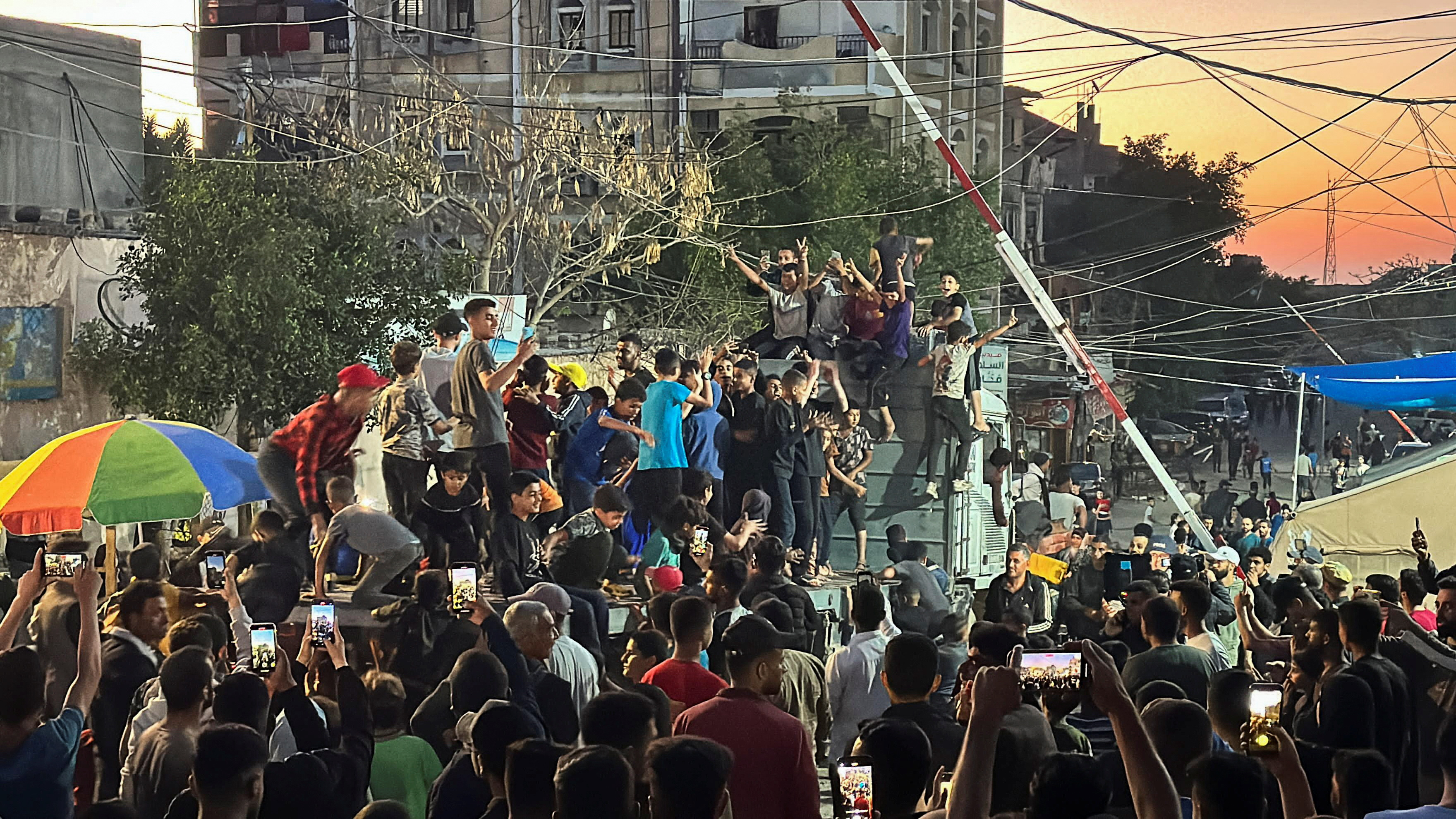
World Chevron
The U.S. issued visa restrictions against executives of several Colombia maritime companies allegedly linked to migrant transportation to the Colombia-Panama border, a senior U.S. official said on Monday on a call with reporters.

China has a lot more missiles — with US warships and bases in its sights
American warships and bases in the Pacific are within reach of an increasingly worrying threat, a daunting missile force unlike any the US has faced in combat before.
China's ever-expanding Rocket Force is armed with thousands of missiles with ominous nicknames such as "carrier killers" and the "Guam Express."
US military leaders and officials say these weapons could make a war in the Indo-Pacific devastating for American forces. And that's exactly the message they say Beijing wants to send, that messing with China would be catastrophic.
The dangers are startling. An American air base such as Andersen on Guam that routinely hosts US bombers or a carrier strike group sailing in the South China Sea could face dozens, even hundreds, of ballistic missiles in salvos intended to overwhelm their defenses, shatter critical capabilities, and send US warships sinking into the depths. China's missiles haven't been tested in combat, but the threat is real.
In interviews with Business Insider, current and former military officials and defense analysts described the meteoric rise of China's People's Liberation Army Rocket Force as a chief concern. One senior defense official said it's changing America's appetite for war in the region, "creating a conventional deterrence capability that threatens our posture, our presence, and our activities in ways that would potentially cause decision-makers in Washington to consider the risks to be too high."
From 2021 to 2022, the Chinese military effectively doubled its stock of some missiles, including the medium-range ballistic missiles it might use to target American military bases in Japan and intermediate-range missiles that are able to reach Guam, the Pentagon said in its most recent report on the military threat from China.
The "dramatic expansion" of the Chinese missile arsenal, especially MRBMs and IRBMs, is designed to threaten US forces and allies across the Indo-Pacific region, Thomas Shugart, an adjunct senior fellow at the Center for a New American Security and a retired US Navy submarine officer, said.
What these key developments show "is that the PLA leadership has decided that the long-range missiles are a winning capability for them," Bryan Clark, a retired US Navy officer and defense expert at the Hudson Institute, said.
The current commander of US Indo-Pacific Command, Adm. John Aquilino, said in his final public interview before he retired that during his tenure as commander, "the security environment has changed drastically and not in a good way," calling China "the most concerning security threat that exists."
China's growing, far-reaching arsenal
China's military doctrine focuses heavily on maintaining the ability to deter threats and, failing that, striking fast and hard. It also encourages maintaining an element of surprise before dealing significant damage to its foes. The People's Liberation Army Rocket Force gives it such an option.
It "is designed as a mechanism to deliver an anti-access, area-denial (A2AD) strategy to push the US and allies and partners from the region," retired Adm. Harry Harris, a former commander of Pacific Command and former ambassador to South Korea, told BI.
He said that the force's "objective is to be able to enforce the illegal and illegitimate claim of everything inside the nine-dash line as sovereign Chinese sea and airspace, as well as forcibly bring Taiwan under Beijing's control."
The nine-dash line refers to China's vast claims in the South China Sea, including its human-made islands and others it has disputes with neighbors over.
Harris said China's advancing missile capabilities concerned him more than any other Chinese military developments during his time as the 24th commander of what was then Pacific Command.
The Taiwan Strait is one area where the Pentagon has said China is strategically expanding its Rocket Force with "new missile brigades, potentially indicating an increasing number of deployed missiles."
Experts said this was part of a larger strategy to prevent the US and its allies from gaining unrestricted access to the Pacific region — whether in a war or in a scenario where US forces attempt to come to Taiwan's aid during a Chinese blockade or invasion .
With these missiles, China is signaling that it could attack US bases and ships in the region with little to no warning, Clark said. One such missile, the DF-26, has been commonly referred to as the "Guam Express" or the "Guam Killer" because it can reach US forces on the island, which is roughly 3,000 miles from Beijing.
The weapon, capable of carrying both nuclear and conventional payloads, also has an anti-ship role and another nickname: " carrier killer ." The People's Liberation Army Rocket Force's DF-21D is another such missile that China could use to target US ships.
There's a lot more to the Chinese Rocket Force than these weapons, though. Other elements of the PLARF arsenal are its DF-17 hypersonic missile, short-range ballistic missiles such as the DF-15 that give it the ability to strike Taiwan with relative ease, and intercontinental ballistic missiles like the DF-5s, DF-31s, and newer DF-41s.
Newer developments, the Pentagon said last fall, "will significantly improve its nuclear-capable missile forces and will require increased nuclear-warhead production." The US Defense Department estimates China has more than 500 operational nuclear warheads, the third most in the world, and that number is expected to increase.
While some are based in silos, many of China's missiles are road-mobile assets or hidden in caves and mountains, making them harder to kill. And outside the Rocket Force, Chinese submarines carry long-range missiles. Its H-6 bombers can do the same. Any confrontation with China must account for the likelihood that many of its nuclear forces would survive direct strikes.
In regard to the Chinese "carrier killer" missiles, satellite-imagery analysts have for years been finding mock-ups of US aircraft carriers and other warships out in Chinese deserts. The suspected targets suggest that China may be relying on these mock-ups to improve its missiles or to practice locking on to and hitting American warships. China has also conducted tests at sea, at least one against a moving target.
After the Pentagon's latest report on China's military power came out, Shugart suggested the sheer number of DF-26s and launchers could turn the missile into a generic "ship killer," available for strikes on not just high-value carriers but also destroyers, cruisers, amphibious assault ships, fleet oilers, and more.
And China doesn't have to sink a ship to score a combat kill. Damaged vessels would have to limp back home, where US repair and maintenance woes could mean a slow recovery.
That changes considerations for US Navy vessels when operating in the Indo-Pacific and raises questions about the role of aircraft carriers in a conflict with China, as they may not be able to get within the strike range for F/A-18s or F-35s.
At a certain range, Clark said, "you're going to have to expend so much effort trying to conceal your presence and prevent targeting by Chinese forces, it's going to constrain your ability to do air operations" from a carrier. And the jets might not even be able to reach their targets.
China's missiles could also influence how the Navy arms its warships, forcing them to carry more air-defense missiles at the expense of other weapons that may be useful in land-attack missions or a confrontation with China's larger navy.
Better defenses, but more work to do
In the vast Indo-Pacific region, the Rocket Force is one of the US military's top concerns "because of its unique capabilities to execute long-range precision fires while not exposing large numbers of personnel to danger," a senior defense official told BI, speaking on the condition of anonymity to discuss intelligence observations of threats in the Indo-Pacific.
Facing this threat and others from China, the US has expanded its training exercises and strengthened connections with its Pacific allies and partners to counter not only PLARF but also the broader Chinese military, the official added.
Experts and analysts have long called for the US to respond to the challenges from China in a way that recognizes the scale of the threats at hand, which goes far beyond the Rocket Force, as frequent risky and unsafe intercepts of US and allied aircraft by China have shown.
Harris said one of the best ways to counter PLARF would be to make "robust" air and missile defenses a reality this decade in the region, with the US positioning land-based, medium-range ballistic-missile systems there, working closer with allies, and not letting China determine US foreign policy in the area, especially with Taiwan.
The US has beefed up its air defenses in the region, employing Terminal High Altitude Area Defense batteries in South Korea and working with Japan's navy on ballistic-missile interceptors such as the SM-3 Block IIA as part of the Aegis Ballistic Missile Defense System. And in Guam, the Army has fast-tracked a new project and office for the island's defenses. But experts argue that more is needed.
Robert Peters, a research fellow on nuclear deterrence and missile defense for the Heritage Foundation, wrote in January that the US should station Aegis Afloat cruisers near Guam that are equipped to defeat ballistic missiles. Peters said the US couldn't afford to lose Guam, and the land-based Aegis defense option is likely years from deployment.
"Should a war with China break out, conventional thinking is that China would launch a large salvo of cruise and ballistic missiles at Guam to destroy military bases there that are key to US military operations throughout the Pacific," he wrote, adding that an attack would be a "modern Pearl Harbor" that could hinder power projection and logistics.
Beyond strengthening air defenses, the US can also harden bases in the Pacific so that infrastructure, such as critical runways, could survive a barrage and still launch aircraft. But the disaggregation and dispersal of forces is also important. Fixed bases are targets that can only brace for an attack, not avoid them.
The US Air Force turned to a new doctrine in August 2022 that assessed : "New weapons systems now place bases at risk that were previously considered sanctuaries." That shift led to the creation of Agile Combat Employment, which looks to atypical approaches to keep key assets from being destroyed.
Agile Combat Employment considers highways, fields, beaches, and more as nontraditional runways to create "a network of smaller, dispersed locations that can complicate adversary planning and provide more options for joint-force commanders." China can target runways at air bases, but it can't hit every piece of concrete in the Pacific.
US ground forces in the region are also keeping an eye on the Chinese Rocket Force, but they're less concerned than the other service branches that China more clearly has in its crosshairs.
The US Army Pacific commander, Gen. Charles Flynn, told BI that while the growth of the Chinese Rocket Force had been "meteoric," PLARF's missiles were "primarily designed to defeat naval and air power."
"I'm always worried about rockets," Flynn said, but they're "not there primarily to defeat distributed, dispersed, mobile, some fixed and some unfixed, reloadable, and meshed land-forces network," which his command and its allies in the Pacific have been developing and prioritizing.
That said, he added, there are many ways for ground forces to create a " dilemma " for Chinese missile forces, such as masking signatures, hiding in different environments, and undermining PLARF's ability to find, locate, and target them.
Beyond defensive measures, the US has various offensive options for combating the Rocket Force.
Difficult-to-detect American submarines can, for instance, fire cruise and ballistic missiles. Stealth bombers, like the B-2 Spirit, can also avoid being spotted while on missions to knock out China's weapons. The US doesn't have the missiles to counter China in this theater of operations, though these systems are in development.
Weak points in the missile game
PLARF may be, as Shugart has said, the " crown jewel " of the Chinese military, but it's not without its limitations. Recent high-profile cases of corruption across the army, in particular in PLARF, have raised questions about how widespread graft may be — and whether that's affecting readiness in the short term.
US intelligence has documented several cases of supposed corruption, including missiles filled with water rather than rocket fuel and problematic silos. Military leadership shake-ups , too, have sparked concerns, as many senior officers and bigwig defense leaders were replaced with little to no explanation.
That said, the US and its allies can't afford to assume the Rocket Force won't be ready should conflict come.
"They now have the world's largest navy, the largest air force in the region," Clark said, "but they invest substantially in these long-range missiles because it's clear that they see that as a more reliable capability."
But clarity on the threat gives the US options. Knowing that China could lean on its missiles in a Pacific showdown allows American forces to train and adapt to work around such a threat.
"Deterrence is a combination of a country's capability and willingness to use that capability," Harris said, "and an adversary's perception of both." In other words, how the US prepares itself and adapts to the Chinese Rocket Force gives it the best shot at avoiding a fight altogether. But there's no guarantee deterrence holds.

Related stories
More from Military & Defense
Most popular
- Main content

North Korea's Cruise Missile Tests Escalate Tensions Amidst Stalled Diplomacy
N orth Korea has once again ratcheted up tensions with the firing of several cruise missiles, according to South Korea’s military. The launches took place near Sinpo, a key military shipyard on the North’s east coast where missile-firing submarines are constructed. This latest demonstration of North Korea’s expanding arsenal raises concerns about regional security and the potential for escalated military confrontation.
The recent missile tests are part of a broader series of weapons demonstrations that include last week’s unveiling of a new cruise missile, Pulhwasal-3-31, and the test-firing of the country’s first solid-fuel intermediate-range ballistic missile on January 14. These activities underscore North Korean leader Kim Jong Un’s efforts to develop weaponry capable of evading missile defenses in South Korea and Japan, as well as targeting remote U.S. assets in the Pacific, such as Guam.
Pyongyang’s steady pace in cruise missile launches, at least ten rounds since 2021, demonstrates an aim to enhance its strike capabilities. The claimed range of these missiles, up to 2,000 kilometers, poses a stark threat to U.S. military bases in Japan. Although these cruise missile activities are not directly banned under United Nations sanctions, experts warn they pose a serious threat due to their ability to fly at low altitudes, making them harder to detect by radar.
Tensions on the Korean Peninsula have been on the upswing for months, with Kim Jong Un continuing to advance his weapons development and issuing threats of nuclear conflict against the U.S. and its Asian allies. In response, the U.S., South Korea, and Japan have been intensifying their military exercises and refining their deterrence strategies, involving nuclear-capable U.S. assets.
North Korea, meanwhile, has described its weapons tests as part of regular efforts to strengthen its military and indicated that some missiles have “strategic” purposes, suggesting they may be intended for nuclear armament.
The implications of these developments are far-reaching. On the one hand, they reflect North Korea’s determination to bolster its leverage in any potential future negotiations with the U.S. On the other hand, they complicate the already strained security situation in the region. North Korea’s actions have not only drawn sharp condemnation from South Korea and Japan but also from the U.S. These missile tests come at a time when diplomacy with the United States and South Korea remains stalled, with observers suggesting that Pyongyang believes an upgraded weapons arsenal could grant it greater concessions should talks resume.
Relevant articles:
– North Korea fires missile into ocean in its latest weapons launch, South Korea says , ABC News, 05/01/2024
– North Korea fires salvo of short-range ballistic missiles , Yahoo News UK, 04/29/2024
– North Korea fires ballistic missiles as Blinken visits Seoul , Yahoo News Canada, 04/29/2024

- International edition
- Australia edition
- Europe edition

Ukraine war briefing: Ukrainians ‘have the right to strike inside Russia’, says David Cameron
France’s Macron stands firm on potentially sending troops; sanctions on Russian gas leave Gazprom with record annual loss. What we know on day 800
- See all our Russia-Ukraine war coverage
Weapons supplied by Britain to Ukraine can be used to strike inside Russia, David Cameron has said , as the UK foreign secretary promised £3bn a year “for as long as it is necessary” to help Kyiv. Patrick Wintour writes that it is the UK’s biggest spending pledge since Russia’s full-scale invasion in 2022. In January, the prime minister, Rishi Sunak, pledged £2.5bn in military aid to Ukraine for 2024-25.
Cameron said: “ Ukraine has the right to strike inside Russia because Russia is striking inside Ukraine … You can understand why Ukraine feels the need to defend itself.” The foreign secretary announced that the UK’s donation of military equipment would include precision-guided bombs, air defence missiles and equipment for 100 mobile air defence teams to shoot down Russia’s drones and missiles.
The UK also committed to doubling its domestic munitions production by investing a further £10bn over the next 10 years. “We’ve just emptied all we can in terms of giving equipment,” said Cameron. “Some of the equipment is actually arriving in Ukraine today while I am here.”
Emmanuel Macron has said the question of sending western troops to Ukraine would “legitimately” arise if Russia broke through Ukrainian frontlines and Kyiv made such a request. In an interview with the Economist, the French president maintained his stance of strategic ambiguity, saying: “I’m not ruling anything out, because we are facing someone who is not ruling anything out .”
At least eight children were injured in the town of Derhachi in Ukraine’s north-eastern Kharkiv region on Thursday when Russian guided bombs struck a site close to a sports complex where they had been training, local officials said. An elderly man was also wounded.
Russia said on Thursday it had captured the village of Berdychi which lies about 12km (7 miles) north-west of Avdiivka – a week after Ukrainian forces pulled out . Over the weekend, Ukraine’s commander-in-chief, Oleksandr Syrsky, said troops had retreated from Berdychi and two other nearby villages to protect “the lives and health of our defenders”.
Russian energy company Gazprom said on Thursday it suffered a record annual loss in 2023 as the European market was practically shut to its gas exports due to war sanctions . The state-owned firm suffered a net loss of 629bn rubles ($6.9 bn/£5.5bn) in 2023 compared with a net profit of 1.23tn rubles in 2022.
The governors of three Russian regions reported that energy facilities were damaged by Ukrainian drone strikes . Oryol region governor Andrei Klychkov said energy infrastructure was hit in two communities. The Smolensk and Kursk governors reported one facility damaged in each region.
The Kremlin has rejected allegations by the US that Russian forces used the chemical weapon chloropicrin against Ukrainian. Moscow also criticised a fresh round of US sanctions – including on entities in China and other countries that western investigators have linked with Russia’s war effort . Several Chinese banks have stopped servicing Russian clients after being warned they could be hit with western sanctions, Russian and western media have reported in recent months.
The Chinese government said it would take “necessary measures” in response to what it called the “illegal and unilateral sanctions” against “normal” trading relations. The US package targets nearly 300 entities in Russia, China and other countries. China has never condemned Russia’s attack on Ukraine and stands accused of indirectly supporting the war .
Nato has condemned an intensifying campaign of Russian “malign activities” on member states’ territory including disinformation, sabotage, violence and cyber interference. Authorities in the Czech Republic, Estonia, Germany, Latvia, Lithuania, Poland and Britain have recently investigated and charged people in connection with “hostile state activity”. In London, a 20-year-old British man has been charged with masterminding an arson plot against a Ukrainian-linked target, while Czech authorities announced in March they had busted a Moscow-financed network that spread Russian propaganda and influence, including in the European parliament.
Vladimir Putin sees domestic and international developments trending in his favour and the war is unlikely to end soon , the US director of national intelligence, Avril Haines, has told the senate armed services committee. “Putin’s increasingly aggressive tactics against Ukraine, such as strikes on Ukraine’s electricity infrastructure , were intended to impress Ukraine that continuing to fight will only increase the damage to Ukraine and offer no plausible path to victory.”
- Russia-Ukraine war at a glance
Most viewed

IMAGES
VIDEO
COMMENTS
The Basics. A cruise missile is basically a small, pilotless airplane. Cruise missiles have an 8.5-foot (2.61-meter) wingspan, are powered by turbofan engines and can fly 500 to 1,000 miles (805 to 1,610 km) depending on the configuration. A cruise missile's job in life is to deliver a 1,000-pound (450-kg) high-explosive bomb to a precise ...
A cruise missile is an unmanned self-propelled guided vehicle that sustains flight through aerodynamic lift for most of its flight path and whose primary mission is to place an ordnance or special payload on a target. ... However, as time progressed, the Soviet Union began to work on air-launched cruise missiles as well . These ACLM missiles ...
How Cruise Missiles Work. HUM Images // Getty Images. A left side view of a Tomahawk air-launched cruise missile in flight after release from a B-52 Stratofortress aircraft, 1979.
Cruise missiles are capable of being launched from multiple ground, air, sea and submarine platforms. Both fighter and long-range bomber aircraft are capable of carrying and launching cruise missiles. [5] On the ground, cruise missiles are most commonly launched by road-mobile systems due to the inherent advantages of mobility, but they can ...
How do cruise missiles work? All cruise missiles have an internal guidance system, though the types vary. The Tomahawk cruise missile, which the U.S. Navy has deployed since 1984, uses a system ...
A cruise missile is an unmanned self-propelled guided vehicle that maintains flight through aerodynamic lift throughout its journey. Its primary mission is t...
The air-launched cruise missile (ALCM) had a length of 6.3 m (20.7 feet); it attained a range of 2,500 km (1,500 miles). It was designed for deployment on the B-52 bomber. The Tomahawk sea-launched cruise missile (SLCM) and the Tomahawk ground-launched cruise missile (GLCM) had a length of 6.4 m (21 feet), a diameter of 53 cm (21 inches), and a ...
Ballistic missiles are different than cruise missiles. Cruise missiles are self-propelled for the majority of their time in the air, flying in a relatively straight line and at lower altitudes thanks to a rocket propellant. Think of a ballistic missile's flight path as a large arc up and back down again, while that of a cruise missile — fired from a warship, for instance — is closer to a ...
Despite being powered by rockets and a jet engine, the Tomahawk missile itself isn't that fast, at least comparatively. It reportedly travels at a speed of around 550 miles per hour. An F-16 ...
Hypersonic cruise missiles are under development by China and the U.S. The U.S. reportedly conducted a test flight of a scramjet hypersonic missile in March 2020. Difficult to defend against
The Tomahawk cruise missile joined the fleet in 1983 and has played a particularly important role in the Persian Gulf War and in actions since the end of the Cold War. Click diagram to enlarge. Flight Profile of Tomahawk Missile Tomahawk missiles can be launched from either a standard 21-inch (53-cm) torpedo tube or, on newer submarines, a ...
The U.S. Navy is set to upgrade its stock of Tomahawk cruise missiles to a new Block V standard. The new missiles can attack enemy ships at sea or land targets with a new multi-effect warhead. The ...
Ballistic missiles have three stages of flight: Boost Phase begins at launch and lasts until the rocket engine (s) stops firing and the missile begins unpowered flight. Depending on the missile, boost phase can last three to five minutes. Most of this phase takes place in the atmosphere. Midcourse Phase begins after the rocket (s) stops firing.
How Missiles Work. By: Marshall Brain. Missiles allow the military to attack enemies from afar. ewg3D / Getty Images. The military uses missiles as one of its favorite weapons, because a missile allows a person to launch a weapon many miles away from the target. At HowStuffWorks you can learn how all of these different types of missiles work:
The Tomahawk is a long-range, unmanned weapon with an accuracy of about 5 metres (16 feet). The 5.6-metre- (18.4-foot-) long missile has a range of up to approximately 2,400 km (about 1,500 miles) and can travel as fast as 885 km (550 miles) per hour. Tomahawks are launched vertically from ships, but they can be launched horizontally from ...
Shooting missiles at other missiles is a hard problem because an incoming threat arrives at great speed, and because the cost calculus can favor an attacker. Interceptors, like shorter-ranged ...
What is a Tomahawk Land Attack Missile TLAM & How Do Tomahawk Cruise Missile Work? According navy.mil, the Tomahawk Land Attack Missile (TLAM) is an all-weat...
Surface ships. Submarines. TELs. The Tomahawk ( / ˈtɒməhɔːk /) Land Attack Missile ( TLAM) is a long-range, all-weather, jet-powered, subsonic cruise missile that is primarily used by the United States Navy and Royal Navy in ship and submarine-based land-attack operations. Developed at the Applied Physics Laboratory of Johns Hopkins ...
fense against cruise missiles. The initial focus of the work at Lincoln Laboratory was to quantitatively as-sess and verify the capability of U.S. cruise missiles to penetrate Soviet air defenses. Two principal areas of technological concentration emerged from this study: (1) understanding and modeling the environmental
The primary defensive countermeasure against ballistic and cruise missiles involves surface-to-air missiles (SAMs): You destroy a missile using a missile. This is no easy feat because the SAM must ...
MIM-104 Patriot short-range anti-aircraft missile systems for defense against aircraft, cruise missiles and medium-range tactical ballistic missiles are located at Rzeszow Airport in Poland, July 24.
CRUISE MISSILES. A cruise missile does exactly what its name says. It cruises, over land or over water. Its working is similar to a jet engine powered airplane. They were developed in the 1930's and 40's and first saw action during World War II where the Nazis used the V1 cruise missile.
The Storm Shadow is a Franco-British low-observable, long-range air-launched cruise missile developed since 1994 by Matra and British Aerospace, and now manufactured by MBDA. " Storm Shadow" is the weapon's British name; in France it is called SCALP-EG (which stands for "Système de Croisière Autonome à Longue Portée - Emploi Général"; English: "Long Range Autonomous Cruise Missile ...
For the first time, Japan's military will receive up to 400 of their own Tomahawk cruise missiles — the newest versions of which can attack ships at sea as well as targets on land from over ...
Iran's attack on Israel included drones, ballistic missiles and cruise missiles. The night sky over Israeli cities lit up as the country's air defenses worked to intercept the projectiles.
May 3 (Reuters) - The Islamic Resistance in Iraq, a group of Iran-backed armed groups, launched multiple attacks on Israel using cruise missiles on Thursday, a source in the group said.
Better defenses, but more work to do. ... Difficult-to-detect American submarines can, for instance, fire cruise and ballistic missiles. Stealth bombers, like the B-2 Spirit, can also avoid being ...
9M730 Burevestnik. The 9M730 Burevestnik ( Russian: Буревестник; "Storm petrel", NATO reporting name: SSC-X-9 Skyfall) [2] [3] [4] is a Russian low-flying, nuclear-powered, nuclear-armed cruise missile under development for the Russian Armed Forces. [2] According to the Russian Ministry of Defense, the missile's range is effectively ...
The recent missile tests are part of a broader series of weapons demonstrations that include last week's unveiling of a new cruise missile, Pulhwasal-3-31, and the test-firing of the country's ...
The Ukrainian president, Volodymyr Zelenskiy, in 2023 signs a cruise missile of the Storm Shadow/Scalp-EG type supplied to Ukraine by Britain and France.